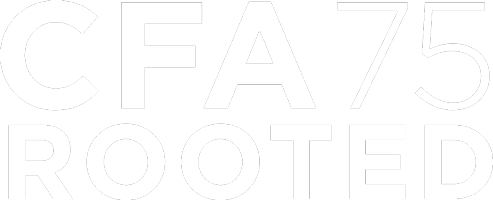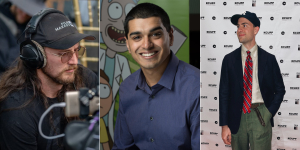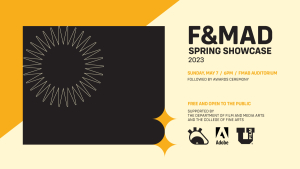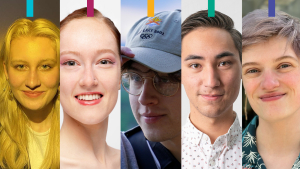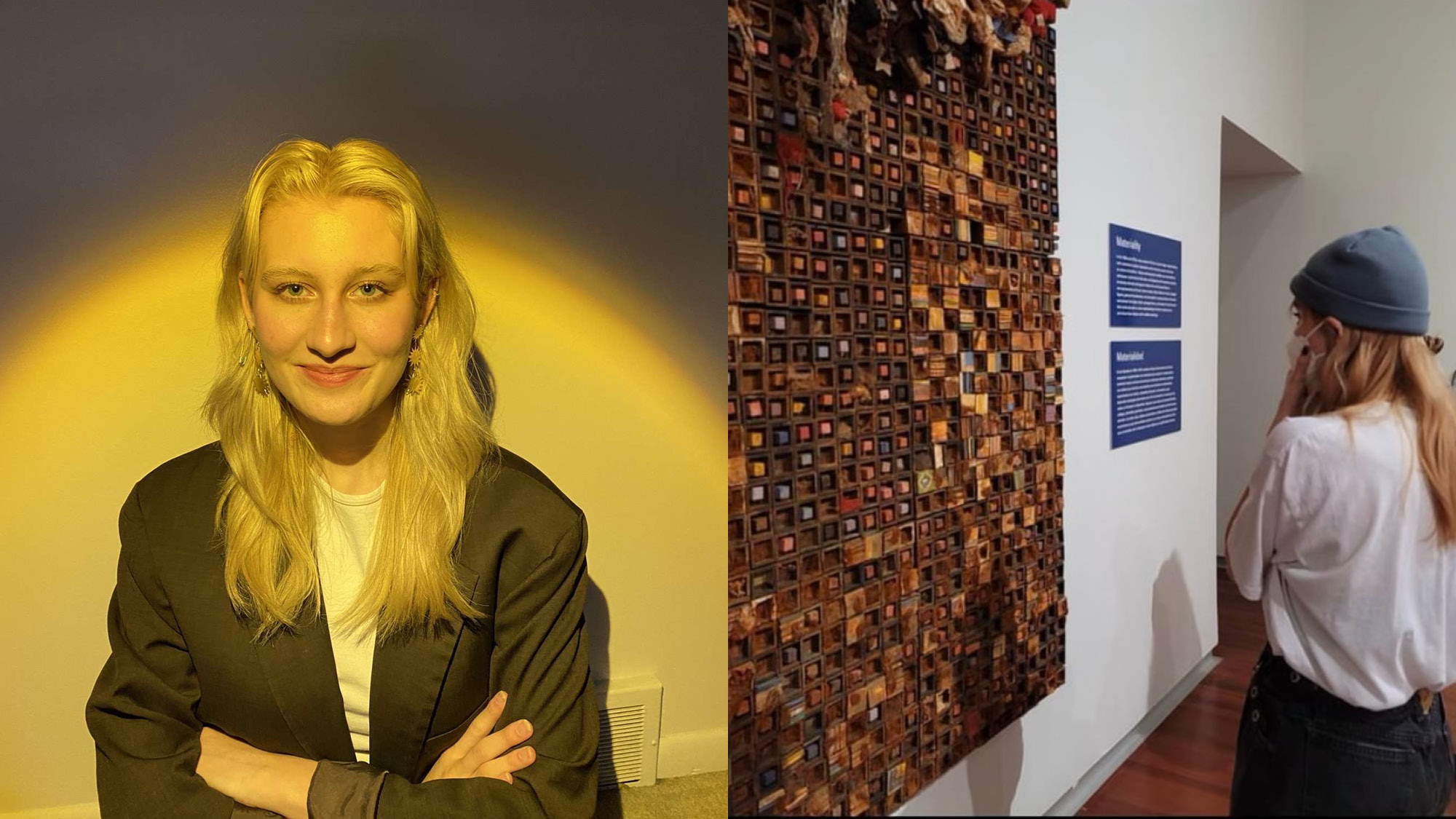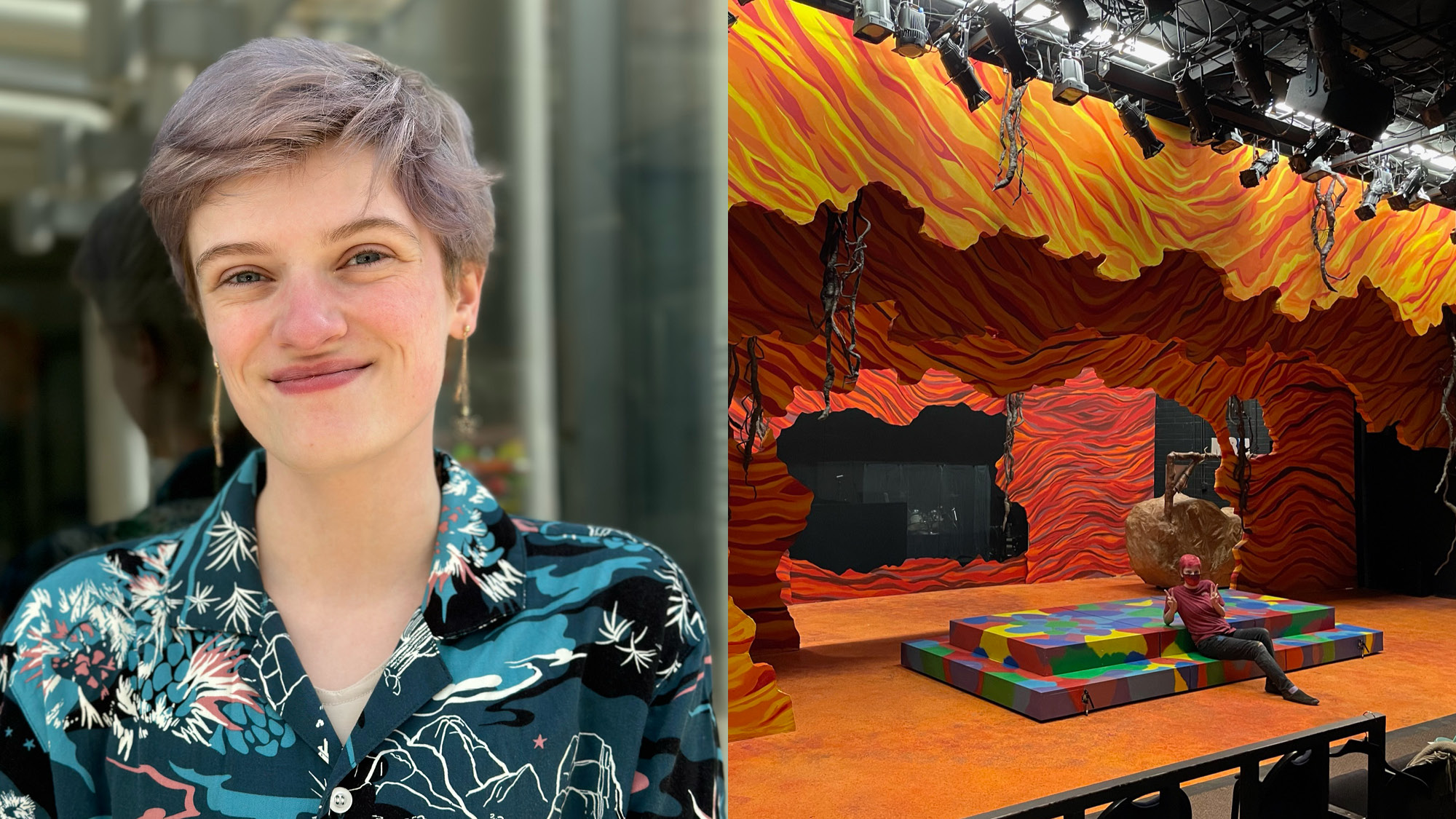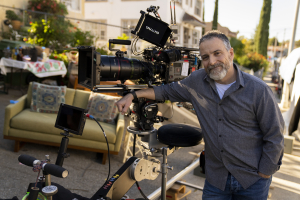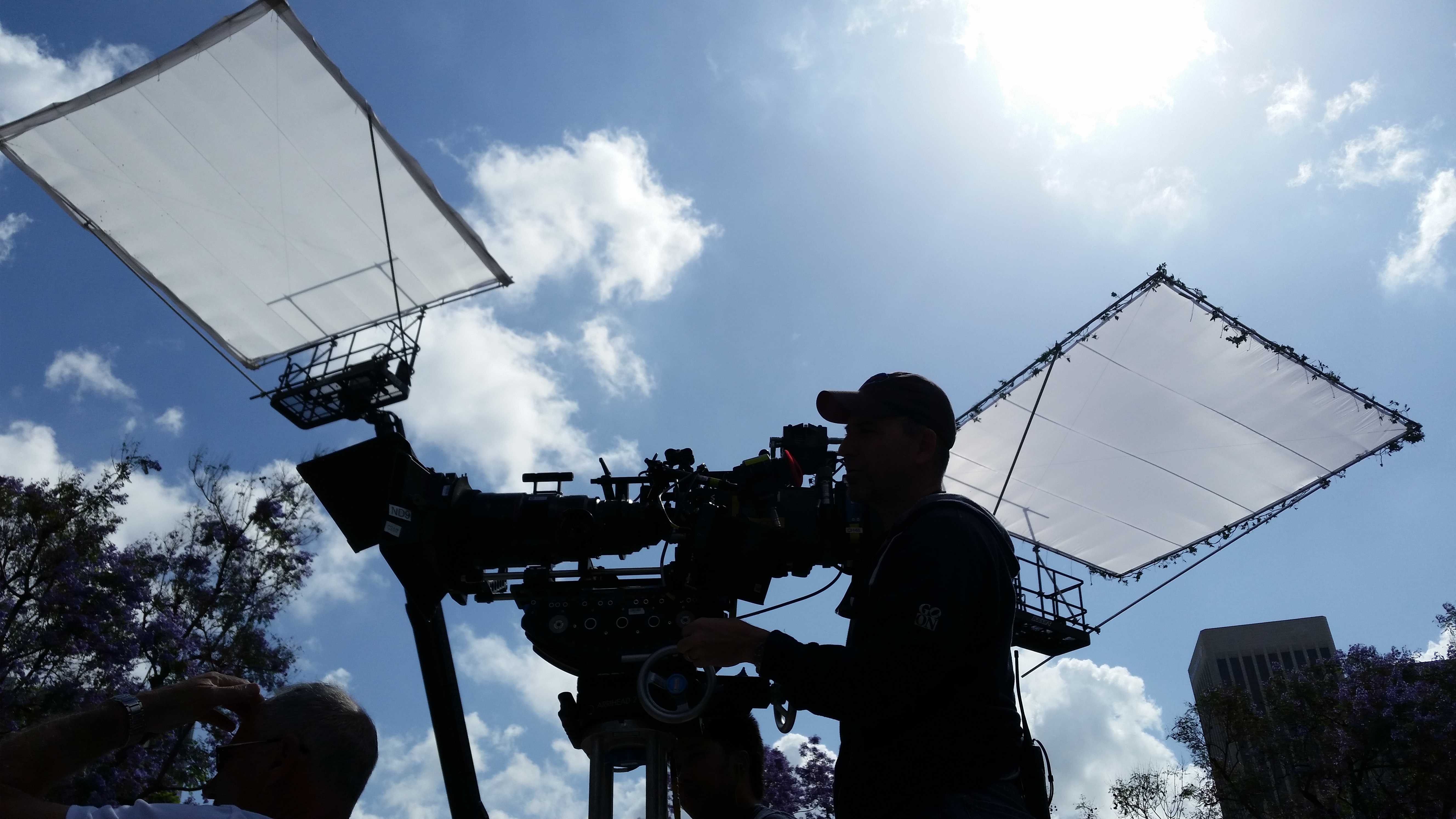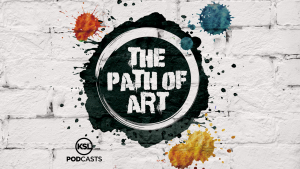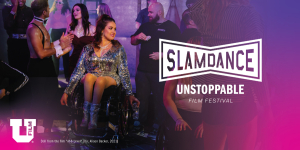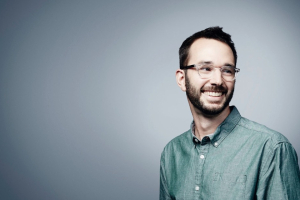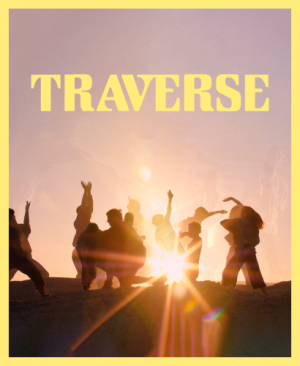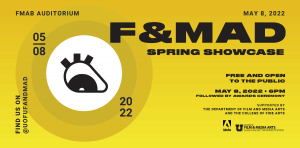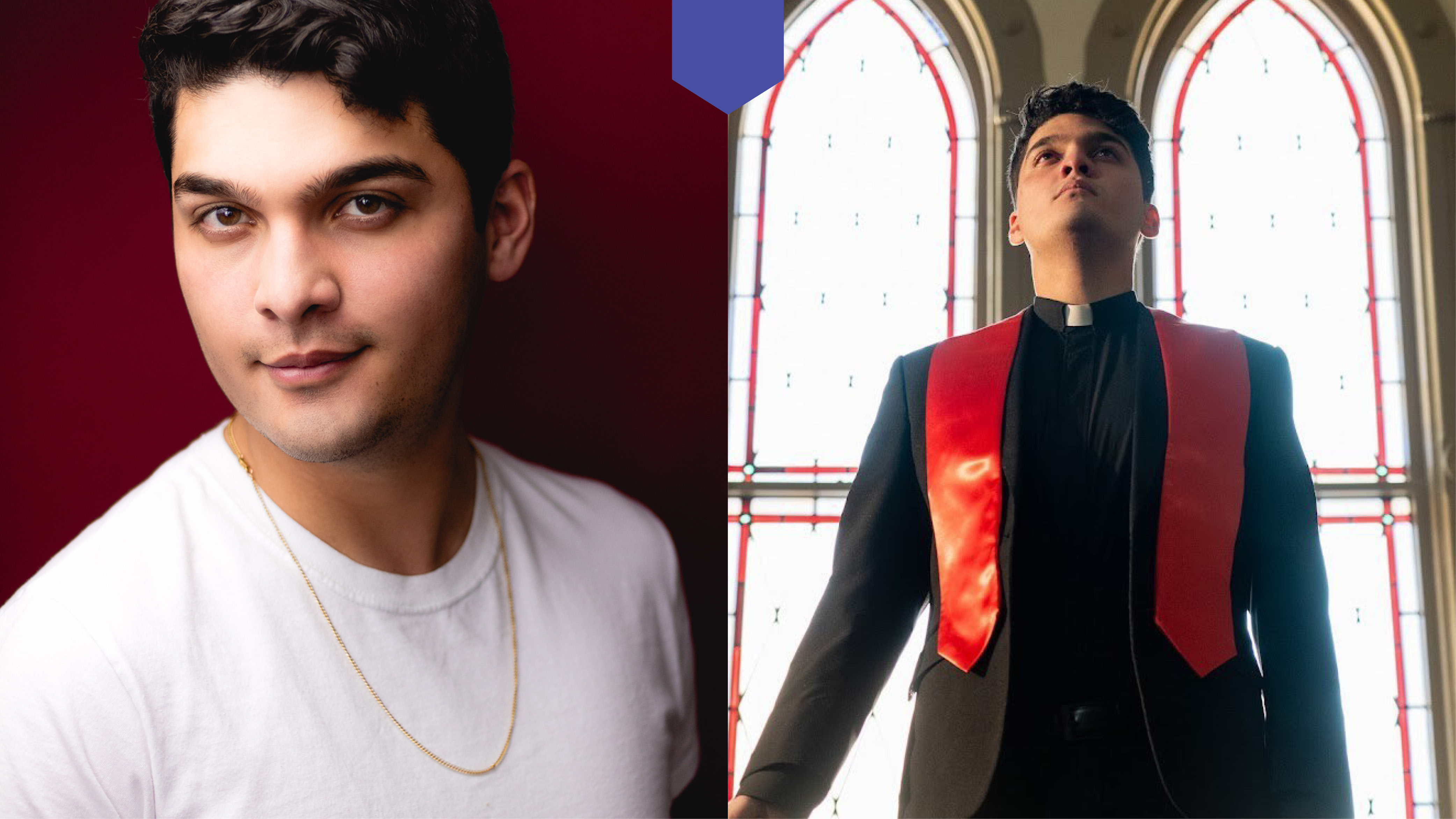Displaying items by tag: Department of Film & Media Arts
ArtsForce Asks: Finding a fulfilling path
By Michael Isaac Palmer
As students in the arts approach careers, it can be easy to become fixated on a specific path. Many film students want to become independent feature directors, many ballet dancers want to become principal dancers of a company, and many theatre students aspire to work on Broadway. Some of them will accomplish those very things!
But for some, including me at times, options that look different than the planned path can feel like failing. Once a goal is in mind, we can become myopic in trying to achieve it. But at the end of the day, the arts are uniquely broad with possibility, and expanding your horizons is often the key to success and contentment.
To explore more on this topic, I spoke with three artists with similar education and ambitions to myself, all of whom are doing something different than they originally planned, on how they found career paths they’re satisfied with and what it took to get there.
“When I first got my start, I worked with a professor of mine as a boom op, because he was still working in the industry. Being friendly and professional on set, actively seeking those connections, got me the next job, and it just went from there."
-Sean Weitzel
Sean Weitzel has always known he was interested in sound, he’s been building out his own gear for years. But when jobs started coming in, he left a bachelor’s degree behind to pursue them. Now, in-between gigs as a sound mixer, he’s developed several pieces of gear in beta-testing on major sets around the country, from a lighter boom pole attachment to a clapboard that syncs with cameras timecode for a fraction of the cost of current models. When I spoke with him, he’d just gotten an oscilloscope to examine the voltage of the timecode output, and when he got more technical than that I stopped being able to follow him. One of the things we talked about was the groups that he tended to work with again and again. Candlelight Media, a family friendly production company based in Orem, had used him as their sound mixer for most of their last dozen productions, and he’d flown around the world with them to do it.
“It was great, like I just stayed in a real castle for two weeks, filming a time-travel rom-com,” he said. Opportunities like that would never be possible if he hadn’t been so flexible as to what he was looking for. “When I first got my start, I worked with a professor of mine as a boom op, because he was still working in the industry. Being friendly and professional on set, actively seeking those connections, got me the next job, and it just went from there.”
Jordan Boge works in creative marketing for CNN. After graduating with a masters in film from the U Department of Film & Media Arts, he cast a wide net for jobs. But it was the internship he’d done right after undergrad that led to his current position. The CNN internship coordinator from his time there had moved to Turner Classic Movies, and was more than happy to have him back under her wing. “It was so important that I’d kept up that connection,” he said. While it wasn’t exactly what he’d gone to school for, it set him up to continue working at Warner Bros. Discovery. For Jordan, never having one “dream job” in mind was key. When I spoke with him, he was frank about needing to keep his horizons open. “While it isn’t exactly what I had in mind while I was in school, I’m really satisfied by what I do, and I get to go home and live a life outside of work.”
Connor Rickman, a University of Utah graduate in both theatre and film, has made a feature length film. It’s awesome. (I may be slightly biased, I worked on it my freshman year.) From the outside, Connor is someone who has done what he wanted to do most. So I was surprised to hear he’s going back to school, to get his MBA from Duke. The more I talked with him, the more I understood how his path is evolving over time. He started as a Production Office Assistant, working his way up to Production Coordinator, but now works for Wrapbook, a film payroll company, as a customer support specialist. His years of experience in the offices of film companies gives him a unique insight into the needs of payroll staff, and he’s getting the MBA to pursue further opportunities at the company. He was quick to say that he had no regrets, that “while the path I was on was not the path I decided to continue, it’s way better than making the safe choice when I was younger.” He elaborated: “It’s so easy for this job to become your identity, because it’s freelance. ‘I’m a gaffer’ or ‘I’m a dolly grip,’ but no, you don’t have to be any one thing.” Flexibility was key for Connor, and it allowed him to work on a lot of different sets, way more than a lot of his colleagues, who always wanted to be just that one thing. “And the connections I made –– I sort of engineered the feature into place,” he explained. Every director will tell students “just go make movies,” but Connor focused more on the people that would get excited to work with him.
Overall, each of these people pay the bills in something related to the film world. They work on projects they’re passionate about, but they also work on projects that help them maintain financial stability. As hard as it can be to accept, you can be happy in the arts in wildly different ways than you’d expect.
ArtsForce Takeaways:
-
Don’t let yourself be defined by a skill you have.
-
Keep your connections, you never know when they’ll come back to help you.
-
Pursue your passions, but expand your horizons while doing so.
-
Always be open to the next opportunity.
Author Michael Isaac Palmer completed a degree in Mathematics, but in defiance of a desk job, stayed in school to pursue Film. He also holds minors in Theatre and French. He is an Emerging Leaders Intern with ArtsForce.
Calling all movie buffs, cinephiles, and anyone looking for a captivating evening out - mark your calendars for Sunday, May 7th! The University of Utah's Department of Film & Media Arts is hosting the F&MAD Spring Showcase, featuring selected student films. This year’s showcase will be held on the UofU campus in the FMAB Auditorium.
The event kicks off with the Silent Theater program at 5:15 pm. This program features films that explore human connections and invite introspection and meditation. The shorts will be played in a dedicated area near the main theatre, allowing audiences to enjoy them while wearing headphones in a single-person setting. The perfect opportunity for some me-time.
At 5:30 pm, it's time for the Black Carpet event. Come dressed to impress and walk the carpet like the star you are. At 6 pm, the Main Theater event begins! This program focuses on the power of motion pictures in exploring storytelling as a collective experience. You won't want to miss out on the opportunity to see some of the best student films on the big screen.
After the films, there will be a Q&A session with the filmmakers from both the Silent Theater and Main Theater programs. This is your chance to ask burning questions about their creative process and inspiration. Afterward, there will be a meet and greet with the filmmakers and the audience at the Student Commons. Refreshments will be provided so you can relax and chat with the filmmakers and other film enthusiasts.
The event wraps up with the Awards Ceremony at 8:15 pm. An audience award will be given to the film that receives the most votes from attendees. Please join us for this exciting event and support the next generation of filmmakers!
***
The Department of Film & Media Arts takes pride in exposing our students to professional practices, and these folks were incredibly generous at sharing feedback to all films. The guest judges for this year's showcase include:
Dania Trapp
Dania Trapp is an Executive Producer at Cosmic Pictures - a wildly curious, award-winning production and post facility focusing on high-quality commercial, feature, episodic, VFX, and new digital mediums. Beginning her career as a journalist, Dania has a passion for capturing stories of people and places through film. While she loves producing both scripted and non-scripted TV series, she has also found an appreciation for working with advertising creatives to produce high budget and innovative commercial campaigns.
Dakota Noot
Dakota Noot is a Los Angeles-based artist and "human paper doll." He has exhibited in galleries and institutions throughout the Los Angeles area, including Charlie James Gallery, Shoshana Wayne Gallery, and the Torrance Art Museum. His work has been featured in Hi-Fructose Magazine.
James Mackenzie
James Mackenzie is a graduate of Loyola Marymount's School of Film & Television in LA. His MFA thesis, Audrey Makes a Mixtape, was recognized on the US BAFTA Student Awards shortlist, and as a member of the Film Independent Incubator Lab, he helmed his award-winning first feature, American Zealot. He recently brought his web series Tough Love to the Tribeca N.O.W. Creators Market and premiered Three Men Named Mantas, an international co-production shot in Lithuania, at the Atlanta Film Festival. He currently teaches at the University of North Georgia.
And without further ado, here are the selected films:
Selected films for Main Theater program:
Running Time 105 minutes
“A Dream of Lettuce” by Doi Ahn | 9 minutes
“Presence” by Brandon Labarge | 7 minutes
“Blue Bedroom” by Riley Mortenson | 17 minutes
“SOLD OUT” by Sofia Guadarrama | 9 minutes
“The Tryout” by Luke Lacey | 12 minutes
“Enactment” by Bridger Roberts | 16 minutes
“An Arrangement of Skin” by Cayden Turnbow | 14 minutes
“JamAIs Vu” by Terri Zitong Diao | 5 Minutes
“Game of Love” by Jacob Hagen | 14 minutes
Selected films for Silent Theater program [In alphabetical order by film’s title]
Running Time 52 minutes
“Things Left Undone” by Ken Gondor | 10 minutes
“My Girlfriend is a Zombie” by Kya l. Christiansen | 5 minutes
“Godalupe” by Sara Serratos | 10 minutes
“Teenage Wasteland” by Loren Degraaff | 8 minutes
“Frenchez: or the Impractical Proceeds of Prioritizing Petty Problems” by Liam Bice | 15 minutes
“Love Sucks” by Lindsay Cruz | 4 minutes
The College of Fine Arts is delighted to present the 2023 Outstanding Seniors from each of our five academic units.
These individuals were nominated for their academic achievements, artistic and scholarly accomplishments, and ongoing commitment to their craft. We are inspired by each of them, and look forward to witnessing the ways they continue to contribute to our community. We are honored to have shared their time here as students.
Congratulations!
Avery Greig
Department of Art & Art History
Pronouns: She/They
Majored in: Art History Major with a Diversity Certificate and a Business Minor
Hometown: I was born in Detroit, Michigan but moved to Utah from Boston, Massachusetts which I consider my second home.
Three words that describe you: Driven, Visionary, and Open-Minded
Most impactful class or professor: My most impactful professor at the U has been Professor Sarah Hollenberg! She is a wonderful professor who urges her students to think about varying perspectives — which has greatly impacted the way I think as an undergraduate student. I really enjoyed working with her when I was the President of the Art History Student Association (AHSA), of which she was our faculty advisor and truly helped me reach for cool opportunities and get out of my comfort zone. I loved taking her Museum Practices course in which every member of the class was assigned a museum job position and as a class we created our own museum together. I will never forget that.
A CFA moment you’ll never forget: I will never forget taking group trips to the UMFA with the Art History Student Association!
What inspires you: Inspiration surrounds me constantly! I find little bits of inspiration all around me. I am greatly inspired by visual art and music — if you see me walking on campus, I always have my earbuds in and my head in the sky, looking at trees and plants or the shapes of the buildings on campus. Music and visual art really inspire me in my writing in the Utah Daily Chronicle, often when I find myself stuck I will turn to various forms of art media to get my writing flow back. My brilliant mother, strong father, and hard-working brother all inspire me and support me to reach my goals each and everyday, and I am inspired greatly by my beautiful and creative friends who push me to reach for big and bright things.
Summary of major accomplishments on or off campus: I was a pre-professional ballerina at the Boston Ballet when I was in high school, President of the Art History Student Association at the U and Arts Desk Editor at the Daily Utah Chronicle. In my time as AHSA president, I co-organized a successful three part professional lecture series centering on underrepresented voices in the art world, bringing in professionals to talk to university students. Last year, I was awarded 1st Place for Best Arts Writing for the University of Utah’s Student Media which was a big honor. I also held an internship with the Utah State Department of Arts and Museums where I worked directly with the state art archive. I am extremely honored to be named this year's Art and Art History Department Outstanding Senior.
Hopes and plans for the coming year: This coming year, I am hoping to transition into an archival-based job position while I start planning for graduate school! I am planning on pursuing a Masters in Library Sciences graduate degree. Additionally, I plan to travel around this summer, including a trip back home to Boston and to Florence, Italy!
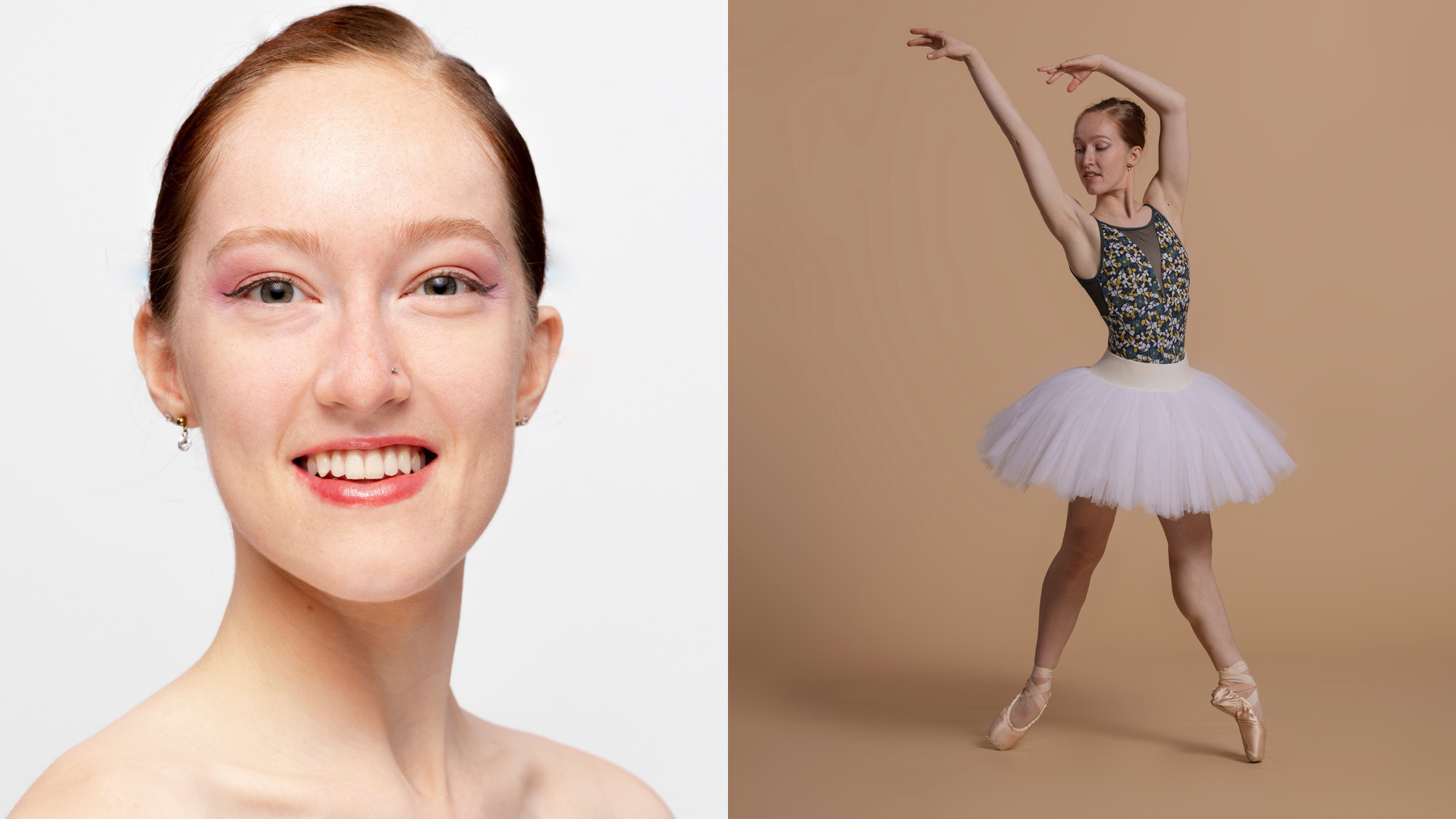
Megan Lynch
School of Dance
Pronouns: She/Her
Majored in: Ballet BFA, History BA
Hometown: Winona, Minnesota
Three words that describe you: Dedicated, passionate, optimistic
Most impactful class or professor: It is difficult to narrow it down to one person, but I find that Pablo Piantino is woven throughout my entire four years in the School of Dance. He has simultaneously challenged and encouraged me to be my most authentic self, and exude excellence both on and off stage, inside and outside the classroom. I also find that Christopher Alloways-Ramsey, Justine Sheedy-Kramer, and Maggie Tesch, who have advocated for me and mentored me over the years are also essential to my success.
A CFA moment you’ll never forget: During my first performance with the School of Dance, the entire cast I was performing with got a card and signed it to encourage me. It taught me the importance of creating a community that cares and supports each other, and how a small act of kindness and encouragement can make such a large impact. I still have the card to this day and make a point to do similar acts for my peers.
What inspires you: I am inspired by kind and passionate people in any area of study, willing to share that passion with others.
Summary of major accomplishments on or off campus:
- Merit Scholarship, Ballet Department
- Service Scholarship, College of Fine Arts
- Ungraduated Research Opportunity Program (UROP) scholar and grant recipient
- Research Assistant, Professor ShawnaKim Lowey-Ball, History department
- President of Character Dance Ensemble (2022-23), Vice President (2021-22), Member (2019-2023)
- Vice President of Student Dance Exposure Committee (2021-2023)
- Student Advisory Council (SAC) co-president, School of Dance, Ballet Department Representative
- FAF grant council committee member
- Performed in numerous mainstage performances with the School of Dance, including Kitri in "Don Quixote," Princess Florine in "Sleeping Beauty," and Alejandro Cerrudo's "Second To Last," as well as many other original works by faculty and guest artists.
- Performed in, and choreographed for, peer-directed performances.
- Studied during the summer months with the Joffrey Ballet, Kansas City Ballet School, Utah Ballet Summer Intensive, and International Summer Program in Incheon, South Korea
Hopes and plans for the coming year: Dance professionally in a ballet company, and continue to foster a supportive community, wherever I am.
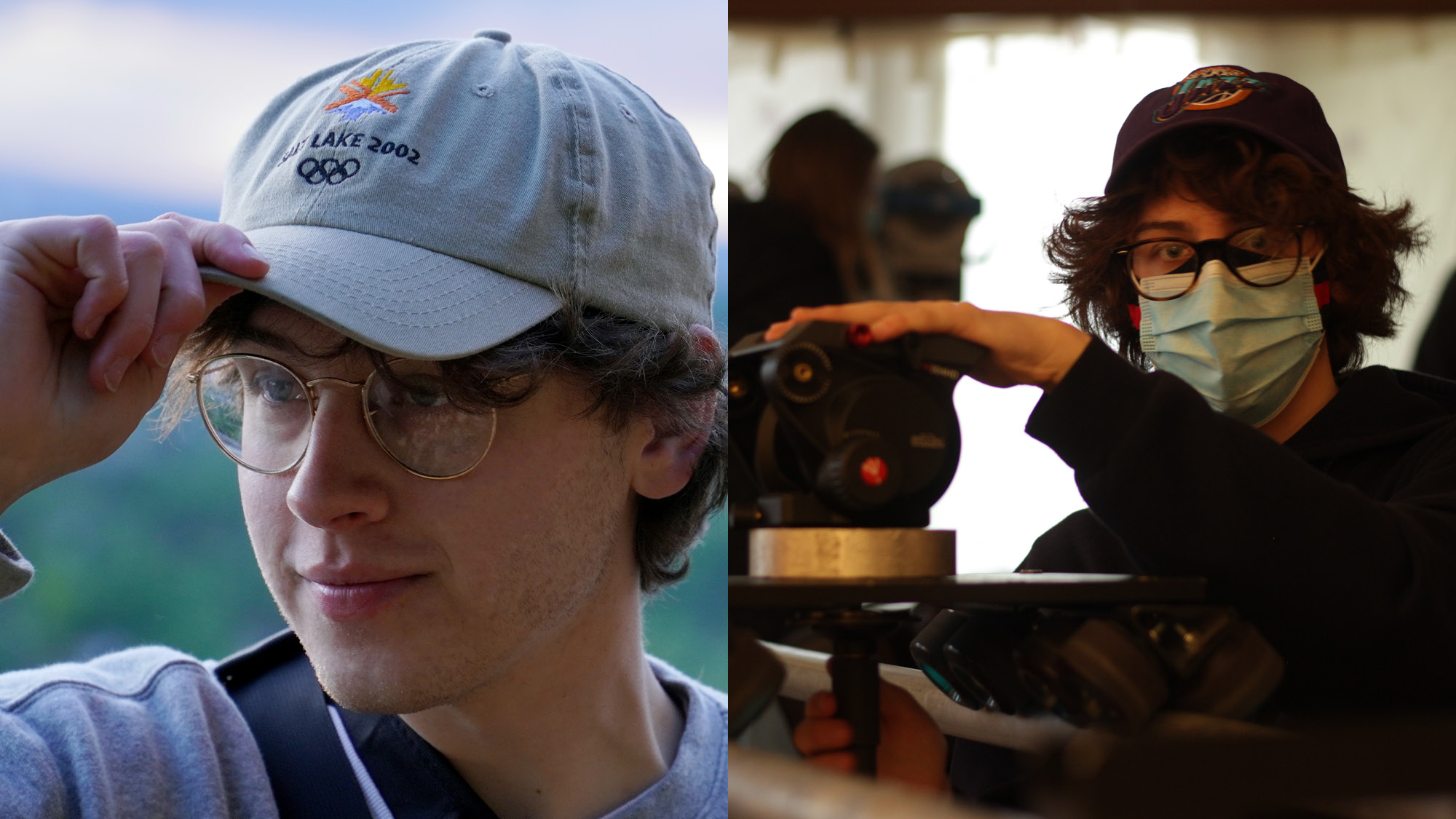
Cayden Turnbow
Department of Film & Media Arts
Pronouns: He/Him/His
Majored in: Film and Media Arts
Hometown: Salt Lake City, UT
Three words that describe you: Leader, Motivated, Creative
Most impactful class or professor: I've had the privilege of taking Paul Larsen's screenwriting class for the last couple of years and have learned so much about how to take and give criticism, how to create a compelling story with interesting characters, and how to maintain self-discipline when writing longer form scripts. Paul Larsen without a doubt has been one of the most impactful professors while I've been at the U and I'll be sad to say goodbye when I graduate.
A CFA moment you’ll never forget: When Lee Isaac Chung visited campus I went to almost every single one of the events he attended and took scrupulous notes. It was his advice that inspired certain aspects of my capstone. He encouraged me to take risks and keep chasing my goals even when times get tough.
What inspires you: I find that it's the people closest to me that inspire me the most.
Summary of major accomplishments on or off campus: I co-founded the Film Production Club and as its president produced and co-directed a short film titled "My Baby" which received a distribution award at the 2022 Spring Showcase. "Toothbrush" is another film that I directed that premiered alongside "My Baby" last year. I've received an Epics award through ADTHING (an advertising agency for which I am the current Video Director) for a commercial I made for Tacos Don Rafa. I've had the privilege of being an RA for the Fine Arts Floor, and a resident of the Fine Arts House. As an Emerging Leaders Intern, I helped organize the 9th annual ArtsForce Networking Event and had multiple articles published in the Finer Points Blog. Last summer I had an internship with Blank Space, a rewarding experience supported by the Utah Film Commission. Shortly after I joined Slamdance as an intern and worked up to managing the online festival in 2023.
Hopes and plans for the coming year: I hope to be able to continue to create, in whatever aspect that may be, as well as find a job that will be a stepping stone for my career in the film industry.
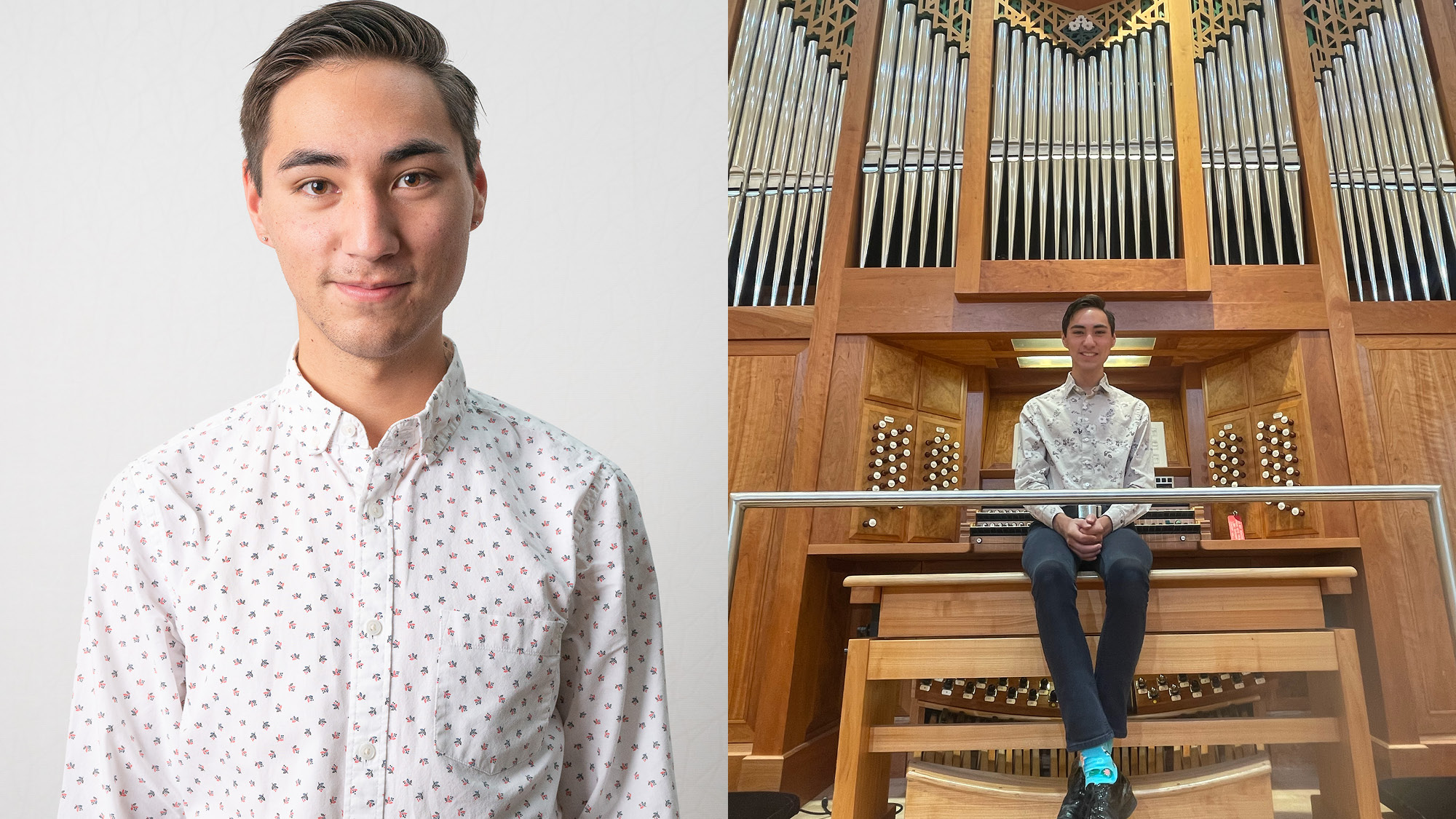
Samuel Judd-Kim
School of Music
Pronouns: He/They
Majored in: HBA in Music and HBS in Philosophy
Hometown: Orem, Utah
Three words that describe you: Tenacious, authentic, disruptor
Most impactful class or professor: If I have to choose just one, it would be Dr. Pamela Jones, for picking up on and nurturing my enthusiasm for learning (both before and during the pandemic), mentoring me on the harpsichord, and directing me toward so many amazing opportunities! However, I would also like to recognize Dr. Ken Udy and Dr. Haruhito Miyagi for their generous support and wisdom.
A CFA moment you’ll never forget: Playing harpsichord continuo with the Utah Philharmonia on a few concerts; as a keyboardist, I always relish the chance to play with an orchestra. An honorable mention would be playing the Libby Gardner Concert Hall organ for the very first time.
What inspires you: All of the talented and visionary artists I’ve had the pleasure of working with; I’m incredibly lucky to have collaborated with so many driven musicians who motivate me to keep doing music.
Summary of major accomplishments on or off campus:
- Two solo organ recitals at the Cathedral of the Madeleine (Salt Lake City) in 2020 and 2022.
- Original senior honors thesis: “Queering the Pipe Organ,” a musicology paper supervised by Dr. Haruhito Miyagi.
- Many joyous collaborative performances on harpsichord and organ, with amazing flautists, harpists, strings, chamber groups, and orchestras.
- With the College of Fine Arts advising team, assisted incoming Fine Arts students as a Create Success Intern
- Helped found the University of Utah Asian Collective, which is working with the Office of EDI to create an Asian Cultural Center on campus and advocates for Asian and Asian-American communities on campus.
- Created workshops on sexual violence prevention for queer students, students in Greek life at the U, and high school students, both as an intern at the Rape Recovery Center and as student staff at the McCluskey Center for Violence Prevention.
Hopes and plans for the coming year: Taking a gap year to explore how to apply the knowledge and skills I’ve learned in the School of Music in an impactful way in my communities. I hope to eventually attend graduate school and build on the research in queer musicology I engaged in for my honors thesis, while always keeping sight of the reasons I do music!
Abish Noble
Department of Theatre
Pronouns: She/They
Majored in: Theatre, Performing Arts Design Program with emphasis in Set Design; minor in Japanese
Hometown: Yokota Air Base, Tokyo, Japan
Three words that describe you: Passionate, Detail-Oriented, Overachiever
Most impactful class or professor: Scenography Lab where I was so excited to assist in building the sets and I realized that I wanted to work in the design part of the theatre world.
A CFA moment you’ll never forget: In scenography lab, I painted a mechanical snake to be used in our production of Men on Boats. That was when Halee offered me a work-study position, and how I could work directly in the shop.
What inspires you: The ability to create amazing things with amazing people.
Summary of major accomplishments on or off campus: Co-set designed the U’s first virtual production in 2020; The Night Witches. I also set designed Storm Still in 2021, and my work was featured in the CFA gala. I was the Scenic Charge Artist for Naked Mole Rat Gets Dressed: The Rock Experience in 2021, and Liminal in 2022. I finished my college career with my set design of the new musical; In Pieces. I have also done some volunteer work off campus for the Utah Pride Festival.
Hopes and plans for the coming year: I plan to continue to work in theatre here in Salt Lake, and hope to work full-time as a theatre technician.
Rick Page is a Director of Photography for television and film and is known for Brooklyn Nine-Nine (NBC, Emmy & Golden Globe), The Sex Lives of College Girls (HBOmax), Grand Crew (NBC), Blockbuster (Netflix), and the award-winning An Uncandid Portrait (2021, Tribeca Film Festival). Starting 30 years ago as a camera assistant, Rick’s extensive career spans television, features, commercials, IMAX, music videos, documentaries, and web series.
As a member of both the International Cinematographers Guild and the Directors Guild of America (DGA), his films have won numerous awards including Best Cinematography, Best Director, Best Screenplay, Best Actor, and Best Short. In 2002, his film Water With Food Coloring was shown in limited theatrical release. He's also earned several Tellys, CINE Golden Eagle and Golden Aurora awards for directing. In 2014, Rick co-created the web series Made Right Here with fellow U of U film alumnus, Matt Springer ’94, produced in partnership with Maxwell House Coffee. Rick shot, directed, and co-produced the 10-part series.
Feature credits include (assisting & operating) The Incredible Burt Wonderstone, Grudge Match, Harold & Kumar 3D Christmas, Legally Blonde 2, This Is It, and High School Musical 3. Network TV includes Benched, Up All Night, Go On, A Lyon in the Kitchen, Promised Land and Touched By An Angel, as well as numerous pilots and mini-series.
After growing up in Buffalo, NY, Rick started making films in high school in Columbia, MD and later graduated with a BA in Film Studies from the University of Utah, earning scholarships and awards for his student films. Concurrently, he learned lighting, camera operating and directing while working at the PBS affiliate, KUED in Salt Lake City. 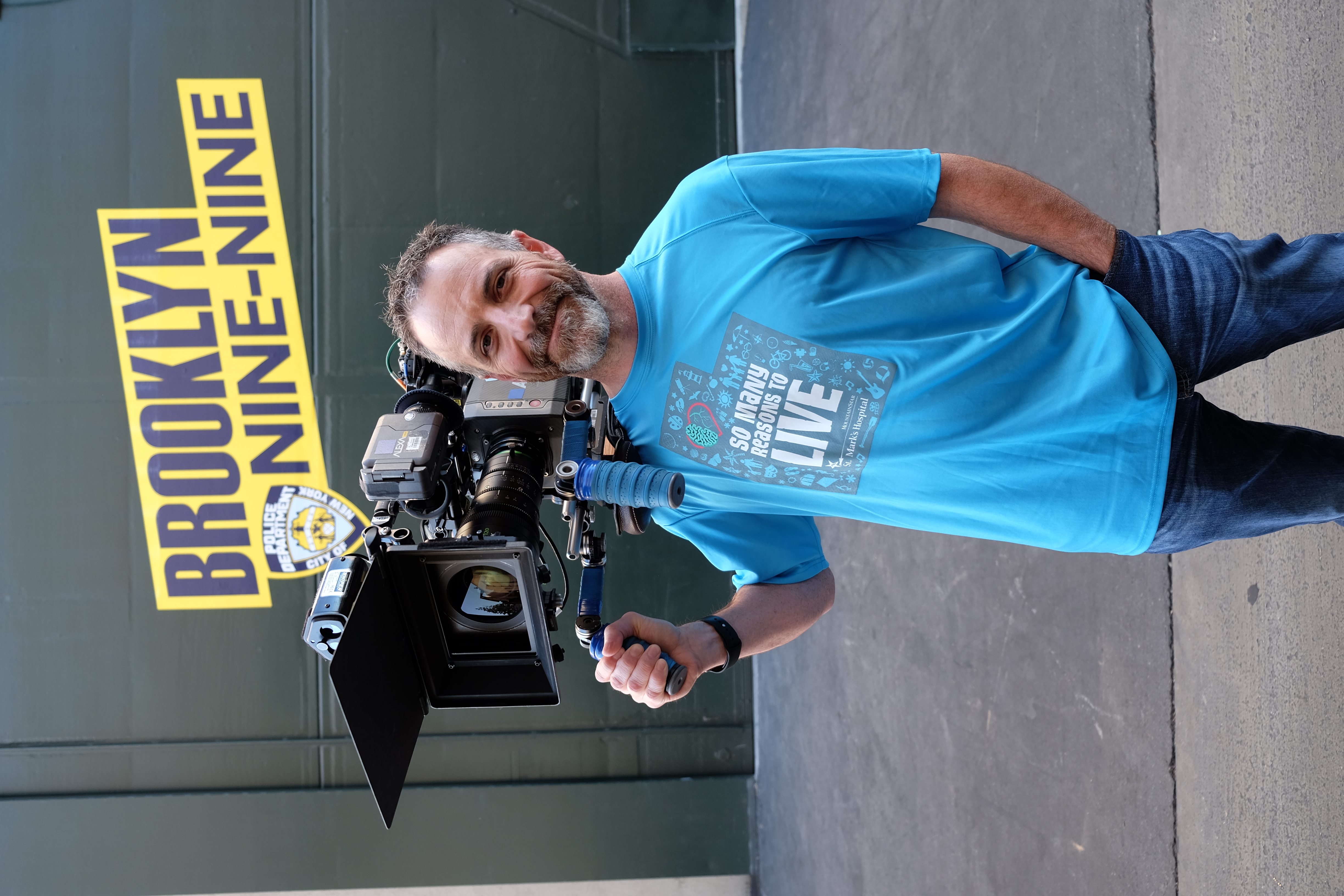 Brooklyn Nine-Nine / NBC Universal
Brooklyn Nine-Nine / NBC Universal
What sparked your early interest in films?
The first impression a film ever made on me was in 1978, it was Richard Donner’s Superman with Christopher Reeve. I grew up in a very small town called Lockport, just north of Buffalo, New York. One Saturday when I was six, my dad took me to the movies. I can remember watching it for the first time and being blown away. I asked him “How is he flying?” He said, “Well, he’s got the red cape.” I said “No, no, but how are they making him fly?” I knew, even at six, that there was a magic trick and I wanted to be in on it. Very early on I caught the bug of wanting to understand the craft behind filmmaking.
Later on, 11, 12 years old, I got into collecting and drawing my own comic books. I’d sell them at school for a quarter. Visual storytelling at its purest.
In 6th grade we had this photography class. We were taught how to shoot film with these pretty basic cameras, then develop it, and print in a dark room. That excited me. Getting images to come to life was magic, especially at that age. And my dad was a photography hobbyist. He loved taking his cameras out and shooting photos with my brother and me, so I think there was some unconscious influence there.
When I got to high school, filmmaking came knocking on the door again. We had moved to Maryland and I joined the track team. I wanted to be included, be a part of something. I ate lunch every day with these four guys from the team who became my buddies. They were all in AP classes. I was not an amazing student. I was more right-brained. I gravitated to History and English (subjects with stories), drama club –– I’d done a handful of plays. The guys were doing this AP English project and wanted to make a little movie. They asked me to run the VHS camcorder. I was the only one who really knew how to work the camera. So we made this short little detective film, very tongue-n-cheek à la Batman and Robin, and cut it together using two VCRs. This was long before computer/digital editing. I remember thinking: why couldn’t we cut our project together by hooking up two VCRs, playing a tape in one, hitting record on the other, then pause the recording, fast forward to another shot, and then un-pause? Then we could use the left channel of audio via RCA cable, and play a cassette for music…boom, editing.
We stumbled onto something big. We had our own little edit bay in our buddy’s basement.
We showed it to the class. That was the spark. The reaction we got from our classmates, our teacher – wondering how we did this – the time we’d spent, the energy, the creativity – it was everything to me. I discovered that all I wanted to do was make films.
What happened next? How did you end up at the University of Utah?
After my friends and I graduated, we decided to make the sequel as a feature length film. We made it with no money – just running all over town throughout the summer, filming at places we worked, casting our friends, family and co-workers as the characters. It was liberating. Then I got a job teaching part-time at a camp and made a promotional video for them. I was doing everything I could to prepare myself for this unknown future. In the fall, I was set to attend UMBC (University of Maryland, Baltimore County). College Park (University of Maryland, College Park) had a small film program that was fizzling out, UMBC had nothing. But I didn’t have the resources to go out of state and I knew I needed to get started somewhere.
So, I started going to UMBC while my track friends went away to colleges out of state. I felt stuck. I just wanted to make films. I didn’t have great SAT scores but I did have a high GPA, and I was doing well at UMBC. I stumbled upon the U and thought, well, it seemed close to California, and I wanted to check out what they had for a film program. I flew out to visit and fell in love with the film department. Something there really spoke to me, inspired me, and I just felt like this was my destination. The canvas was calling me to paint.
I went back to Maryland, took a hiatus from school, and worked for 9 months, balancing six different jobs at 90 hours a week in order to save enough money to get out west. In September of ’91, I boarded a train for $239. I had my duffel bag from track and two footlockers, and I moved all my hopes and dreams out to Utah. I was 19. Got off the train and never looked back.
Once on campus, I found out there was a theatre in the Residence Halls (in Ballif Hall) that screened movies every weekend, and I asked them if they would show my feature. That created a bit of buzz. Seeing it projected on the big screen was something else. Then I talked to the head of the film department at the time, Bill Siska. He said the movie was great, admired my tenacity, but there were no open spots (scholarship-wise) in the department. I could take entry-level courses and come back later.
I only had enough money to get through one quarter. So I became a resident advisor which took care of room and board, and then I got into the work-study program and landed a job at KUED. Quarter by quarter, I eked by on the financial side and kept my nose to the grind. As an RA, I pitched an idea to the residence halls to shoot a promo video. They agreed and actually paid me to do it –– and I got KUED involved, which helped the production value. (I even talked University AirMed into taking me up in a helicopter to get aerial footage of the campus!) I went back to the film department and showed my work. "Okay," Bill said, "I’m going to put you in one of our graduate classes. We’ll give you a partial scholarship." He called Brian Patrick and said, "this is someone we need to get into our program." The rest is history.
What are some favorite moments or experiences from your time in undergrad?
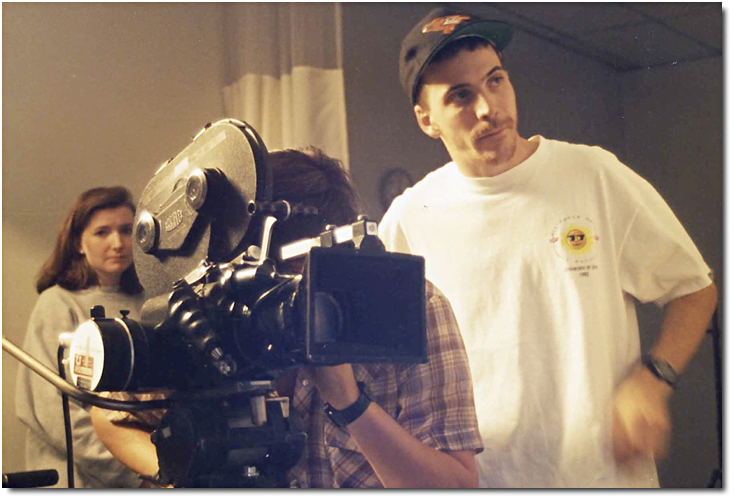 Film School: University of Utah, 1994I am so proud of the fact that I went to the U because I got so much out of film school. I was always the guy who would figure out how to do the extra things – put graphics in for titles, figure out music, props and special FX, just adding extra bells and whistles you typically wouldn’t bring to your student films in those days (again, long before digital and computers).
Film School: University of Utah, 1994I am so proud of the fact that I went to the U because I got so much out of film school. I was always the guy who would figure out how to do the extra things – put graphics in for titles, figure out music, props and special FX, just adding extra bells and whistles you typically wouldn’t bring to your student films in those days (again, long before digital and computers).
Back then, Orson Spencer Hall had this large auditorium where the film history classes were held. We’d watch films on 16mm (eventually we progressed to this new technology called laser disc!). I looked into the department that projected the films, Instructional Media Services out of Milton Bennion Hall, and I went and introduced myself. I asked if I could help project the films and they hired me on staff. So now, I went to classes I wasn’t even enrolled in and projected films. 24/7 film school –– I just absorbed every minute of it.
Countless hours spending all-nighters in editing, living off Mountain Dew and pizza from The Pie. Obsessing over shots and sequences, and trying to find missing frames in the bottom of the bins –– this was our life. Brian Patrick, Kevin Hanson, Dale Elrod, the others, they challenged us to get better at every turn.
I would volunteer to work on everyone’s projects. If I could figure out how to get a moving camera shot, I’d do it. At the time we had this doorway dolly and a wheelchair – you had to get creative. Countless hours spending all-nighters in editing, living off Mountain Dew and pizza from The Pie. Obsessing over shots and sequences, and trying to find missing frames in the bottom of the bins –– this was our life. Brian Patrick, Kevin Hanson, Dale Elrod, the others, they challenged us to get better at every turn. And because I was there all the time, living in the department, and learning as much as I could from my professors and classmates, I got a tremendous education. I treated this like the springboard for me to grow as a filmmaker and prepare me for the future.
Tell us more about your experience at KUED.
Long before the Eccles Broadcast Center was built, KUED was run out of the basement in Gardner Hall in President’s Circle. It was a tiny studio. One of my early work-study jobs was working part-time as a daycare assistant in Research Park. Even there, I was infusing filmmaking into what I was doing, having the kids pretend and act out the stories from the Dr. Seuss books. One of the moms worked at KUED and told me they were looking for interns.
My job was to cut magazine articles for the producer of Civic Dialogue on whatever topic they were covering that week. Ted Capener (Vice President of University Relations at that time) was the host of the show. I couldn’t believe my fortune – working at a TV station, and doing research that actually (possibly) went into the show. I would gladly hang around the studio when they would do the tapings, and I’d watch the camera operators and the activity of the control room. I just started introducing myself to people and finally met the production manager, John Castellano. I expressed my desire to work in the studio and learn camera and lighting, and he snatched me up from cutting the magazine articles. The next thing I knew I was behind a camera with a red tally light coming to life.
I started working on The Coaches Show with Rick Majerus and Coach Mac. Before I knew it, I was floor directing and just learning all I could –– lighting, gripping, tape operating, technical directing, graphics. Later we moved into the (new) Eccles building and it was state-of-the art. We started getting into bigger projects, studio concerts, remote shoots and such. It was an amazing time for me. They all knew of my hopes and dreams to head for Hollywood and encouraged my efforts, including me on whatever I wanted to be involved with. I learned so much with those people at KUED who were kind and generous with their time, and that translated to what I was doing in my classes, and vice-versa.
How did you transition from school into the professional world?
One day in my final year, someone had written on the blackboard a phone message: there was a job opening for an internship –– a TV series shooting in Park City. I took down the number and erased the board. It was super entry level, way down the line, like the producer’s assistant’s assistant’s intern. But I called and said “I’m your guy.” The show was called Extreme for ABC, starring James Brolin, Julie Bowen and others. It was basically Baywatch on snowmobiles. I was running around picking up dry cleaning, restocking snacks in the office, making coffee, answering phones, binding scripts. I was thrilled to be there. I hadn’t officially graduated yet, but I was on my way. 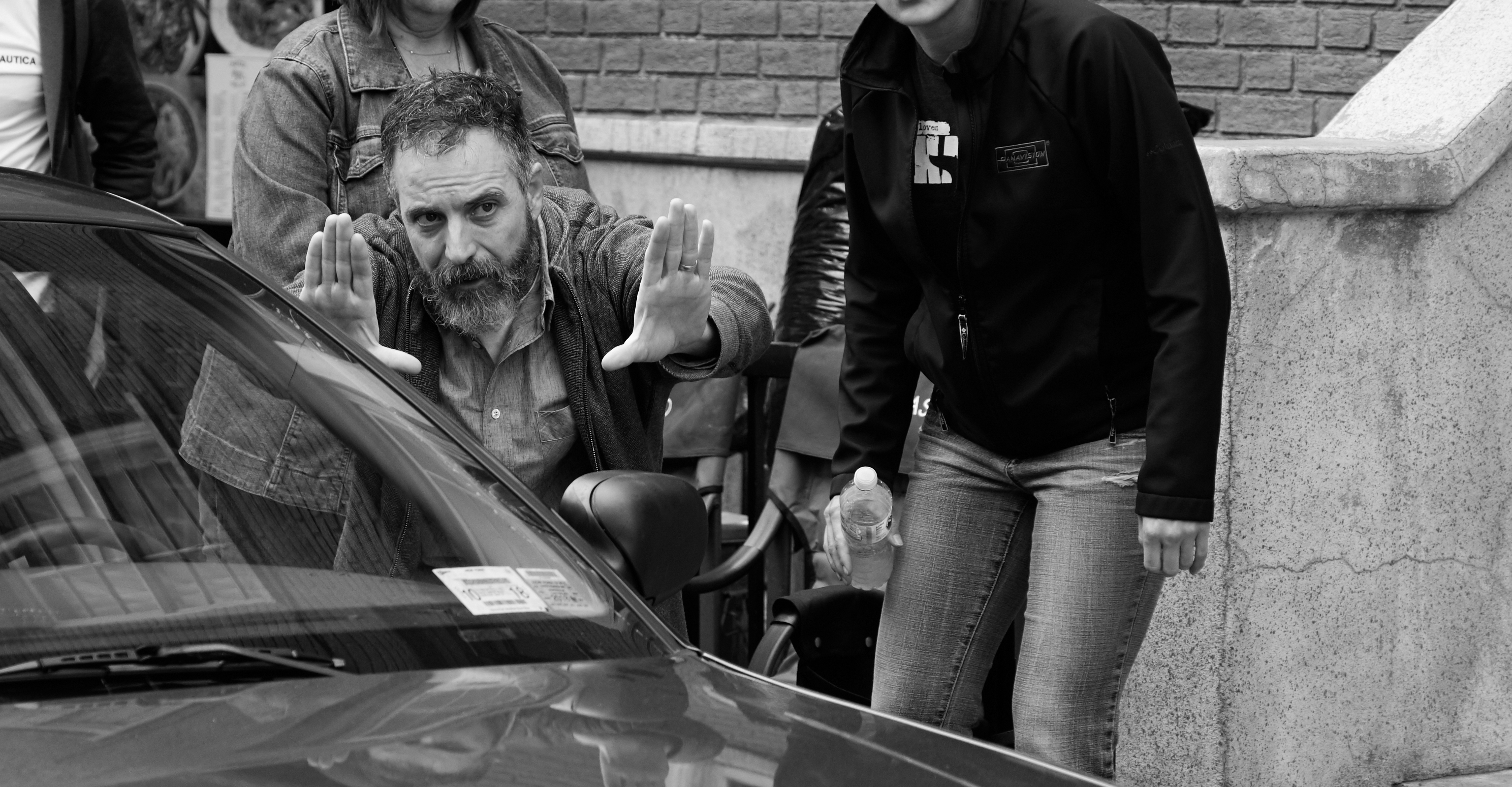 Photo credit: John P. Fleenor | Brooklyn Nine-Nine/NBC Universal
Photo credit: John P. Fleenor | Brooklyn Nine-Nine/NBC Universal
I had been in the production office for about two weeks and really wanted to be on set. The production coordinator said “but you’re so good at this,” and while I appreciated the compliment, I pointed out that if I was getting college credit, and technically paying for said credit, then couldn’t I please go do what I was interested in? She sent me to set as a PA –– I was one step closer. I introduced myself to the camera department. They were breaking for Christmas the next day but invited me to intern with them when production resumed. The first day back I was helping unload the camera truck in three feet of snow, somewhere in Midway. I was ill-prepared with my sneakers and jeans, but it was the greatest thing in the world.
One day in my final year, someone had written on the blackboard a phone message: there was a job opening for an internship –– a TV series shooting in Park City. I took down the number and erased the board. It was super entry level, way down the line, like the producer’s assistant’s assistant’s intern. But I called and said “I’m your guy.”
At the end of three months, working for free, I had formed relationships with a couple of the camera assistants who then brought me onto another job four months later. As I quickly learned, freelance (especially at the start) sometimes means more time off between gigs than not. So while I was figuring out the camera assistant route, KUED’s experience helped me get another job at KUTV, shooting news. I knew I had to be patient and keep trying. It was a matter of putting myself out there – meeting people, being positive, letting people know I was excited and willing to do whatever it took to get the job done. I slowly began to build a network.
When I first moved to Utah, I really thought it was just a stop on the way to LA. I didn’t realize there was already a steady and rather robust film community in Salt Lake with movies, TV series, and commercials. It was the early 90’s and it was thick with production. I found myself in the right place, right time.
So I started to make my mark as a camera assistant. The first half of my career was in Utah. Movies-of-the week, features, commercials, Touched By An Angel for five seasons. Eventually it starts to snowball. I was even traveling around the world on projects. Opportunity can knock every day, but you need to be prepared. If there’s a knock on the door and you’re ready to go, great. If you fumble the ball a couple of times, you might get one or two chances and then you get sent back to the bench. On every job, with every person and every opportunity, I applied myself. I worked hard and kept learning. Attitude was key. If you are dependable and reliable, you may get the job over someone else that has a greater skill set, because people want to be around you 15 hours a day. So it behooves you to care.
What are some of your proudest moments in your career so far?
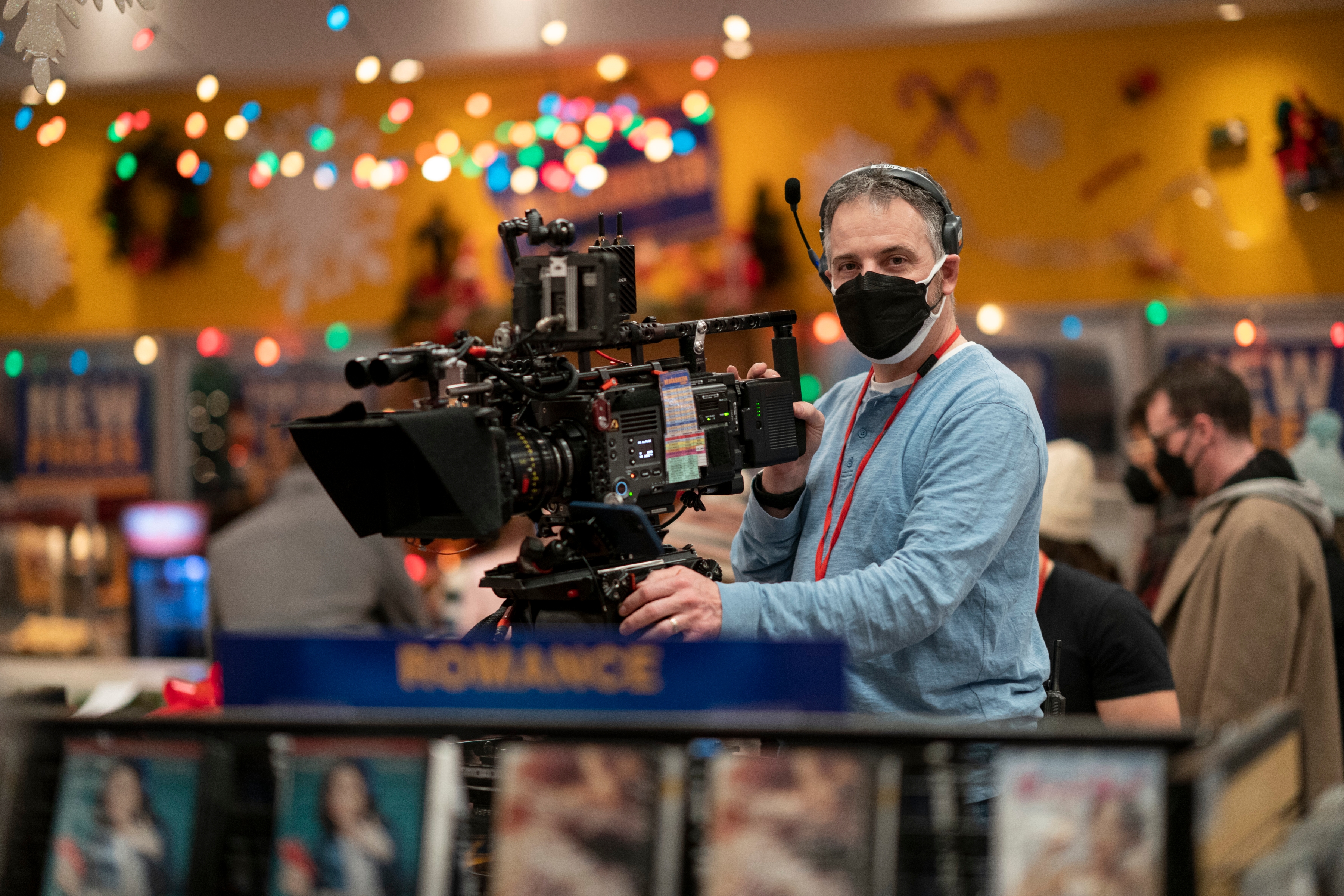 Photo credit: Ricardo Hubbs | Blockbuster/Netflix
Photo credit: Ricardo Hubbs | Blockbuster/Netflix
One is from the finale of season three for Brooklyn Nine-Nine when the showrunner, Dan Goor, was directing. He wanted the last scene of the episode to be a big reveal that the two main characters, Jake and Holt, were now living in Florida. He and the director of photography (DP), who I was operating for, referenced a crane shot from Goodfellas. So we got a Technocrane and designed our version. When you’re operating a shot such as this, you’re directing 4-5 people to work in sync and pull it off. It turned out great (under pressure and all) – the scene played as a oner, and was a fun way to end the season.
Brooklyn Nine-Nine is full of those moments for me. As an operator on that show, I was one (of a select group) who helped form the style of the cinematography that defined the show’s look for eight seasons. I’m incredibly proud of that. During season two in between scenes, I shot a behind-the-scenes featurette with everyone involved. The DP recognized my experience and would push for me to shoot splinter and second units and vouched for me with the producers. I shot a big stunt at Paramount during season three, then bumped up to DP a few episodes for seasons four and five. And then when season six began, the former DP moved on to another opportunity and they promoted me to take over. It was a whole new ball game. I have Matthew Nodella to thank for that. He changed the course of my career.
If I hadn’t done this job and met this person, it wouldn't have led to the next thing. It’s a complex tapestry that you can’t really plan.
I had always sort of felt that I would be a director – and then growing up in cinematography inspired me in new and exciting ways. It’s incredibly collaborative and constantly challenging. In television, directors come and go. But as a DP, you shoot every scene, every episode. You’re working with the crew, cast, writers, and producers all season long. These other shows I have been working on recently –– Grand Crew, Blockbuster, Sex Lives of College Girls –– I love helping design the looks and styles of these shows, helping to craft these stories and work closely with the showrunners, producers, and directors. My appreciation never fades because I get to be creative. I’m part of the team. I feel included. That was something I appreciated way back with my high school buddies, and later with KUED, and my class in film school –– these people included me. The instructors at the U would allow (and encourage) me to do all these extra things and that kept re-igniting my passion and desire to go after it.
I have often thought about this when I’m reflecting on the road map of my life. If I hadn’t done this job and met this person, it wouldn't have led to the next thing. It’s a complex tapestry that you can’t really plan. I worked for and assisted some ACs back in Utah that hired me on jobs where I learned from some really great DPs. And those DPs inspired me and brought me along where I met other people, which lead to other projects. It’s how it works, really. On Brooklyn Nine-Nine, multiple writers have gone on to great success, creating and running their own shows –– three of which I’ve had the honor of working for. These opportunities come from working hard and fostering solid relationships. That’s why you give 200% on everything you do. You never know who you’re going to run into and maybe work for (or with) later in life.
What was most surprising to you about the realities of working on television and film sets?
When I first showed up on set, I was thrilled to be there – the lights, the cameras, the sets. Actors walking around, free food. I discovered that a lot of people did not share this feeling. Not everyone walks around overjoyed that you’re on the same stage where Jimmy Stewart acted in 1953. That surprised me – but the fact is, for some it’s just a job, a way to earn a paycheck. And that’s okay. But for me when you love what you do, it’s not a job, it’s a way to live. I feel a sense of gratitude every time my badge opens the gate at the studios. It’s like, “Look at that, I made it another day.” I work 200 feet from Spielberg’s office… I mean, come on!
The production schedule can be grueling on any given project. It requires mental and physical preparedness. You work out, eat right, you meditate, you have a therapist. Keep your head above water. Learn everyone’s position. Keep your eyes and ears open. Grow a thick skin.
I feel a sense of gratitude every time my badge opens the gate at the studios. It’s like, “Look at that, I made it another day.” I work 200 feet from Spielberg’s office… I mean, come on!
There are plenty of people who feel like they paid their dues and learned the hard way and are just there to do the job. But I subscribe to the idea of paying it back (and paying it forward). I check in with my mentors (the ones who are still around) from time to time, let them know what I’m up to and how I’m trying to do what they taught me.
I had the great fortune once of directing a short film with the legendary actor, Ossie Davis. I was collaborating with some crew from Touched By An Angel and we had pooled together our resources to make this little film.
Ossie was 80 years old at the time. I was a kid. He’d agreed to work with us for a day and we flew him out to Salt Lake from New York. Before we rolled the first shot, I asked him why he was helping us. He said, “Young man, when I was your age and coming up, there were those who helped me along who are now no longer with us. This is how you pay them back, by helping the younger generation to come along.” I try every day to live by Ossie’s generosity.
One more story that takes the cake
When I was in film school at the U, actor/director Robby Benson was an adjunct professor who would visit once or twice a year for guest lectures. He and Brian Patrick arranged a field trip to LA to see a taping for a show Robby was directing called Evening Shade. We got to tour Panavision and some film labs, Disney animation –– it was inspiring as students to see how some of the business works and be around the professionals.
And then we went over to CBS Radford Studios, which is one of the oldest lots in Hollywood, built in 1928. Mack Sennett studios. It later became Republic Pictures where actors like John Wayne, Gene Autry, Roy Rogers started their careers. John Ford shot parts of The Quiet Man there, Gunsmoke was there, later on Gilligan’s Island, eventually Newhart, The Mary Tyler Moore Show. In the 90s, Seinfeld. A wealth of TV history in this place.
Stage 15: it was the first time I ever saw a soundstage. Burt Reynolds walked by and said hello. There was (the first time I’d met him) Ossie Davis, and Michael Jeter, and Charles Durning. Marilu Henner. This was a crazy front row seat –– no audience –– just us students watching the crew block camera rehearsal with the actors. And I met the DP, Nick McLean.
I remember walking outside of the stage doors and seeing the other soundstages across the way. I watched grips pushing dollies around, electricians moving lights, wardrobe racks rolling by, forklifts moving set pieces, and golf carts driving past –– all this studio-lot activity. I thought to myself, “I have to be here. How will I get to do this?” It seemed so far away.
I kept in touch with that DP for a couple years as I was getting into the business, mid-90s. Nick invited me to come by anytime I was in LA, which I happily took him up on. I’d go to CBS Radford and over to Stage 15 to watch whatever was going on with Evening Shade and then later a show called Cybill. Hoping to meet people.
Nick McLean put my eye behind a lens for the very first time, a 14mm on a Panaflex. I’d talk to the camera operators, the dolly grips. Then I’d go wander and watch rehearsals of Seinfeld. I’d just explore the lot and soak it all in.
In 2013, I get hired on a new show called Brooklyn Nine-Nine that was set to shoot at CBS Radford. Now I have a badge. The gate goes up. We are shooting on Stage 12, kitty-corner to Stage 15. It had happened.
Cut to 2021, eight years later. 153 episodes. I’m the DP of that same show. We’d been though eight seasons together –– me and hundreds of others. The series had been cancelled and picked up again. We’d witnessed marriages and divorces, births and deaths. People came and people went. Covid and the year of the pandemic. Bonds of friendship. We went through a lot of life together by the end, which is a rare thing in this business. This was a journey for the books.
I saw the ghost of my former self almost 30 years earlier, that kid from the U, so curious, so hopeful, so determined yet uncertain how it would all happen.
When we shot the series finale, with an amazing gesture, the producers gave me a cameo role in the show with the entire cast in the last scene. What’s more, our producer (Matt Nodella) came up to me before the last day and said “Tomorrow when we wrap, we’re going to empty the stage, and we want only three people to give speeches to everyone. It’ll be Andy (Samberg), Dan (our showrunner) and you. You’ll lead us off.” I only had that night to prepare.
As I spoke the next day, gazing at this massive group of tearful friends and co-workers, I looked over and noticed those doors on Stage 15, just about 100 feet away. I saw the ghost of my former self almost 30 years earlier, that kid from the U, so curious, so hopeful, so determined yet uncertain how it would all happen. What a privilege.
For more:
rickpagedp.com | IG: RickPage_
Alumnus Ryan Meeks produces The Path of Art podcast to inspire
KSL’s “The Path of Art” podcast aims to share the insight of creative people in hopes of inspiring those on a similar path.
As they write in their show description: “The journey to creative success can be different for each artist, but the lessons learned along the way are often similar and act as road signs for those who follow.”
The podcast is the brainchild of Ryan Meeks, alumnus of the University of Utah Department of Film & Media Arts, who also hosts the show.
Meeks has plenty of hands-on experience with the twists and turns of a creative path. It is precisely his own journey, and his genuine desire to help others like him, that inspired him to pitch the concept for “The Path of Art” to the network.
“I wanted to talk with those people that are seeing creative success and ask them how it happened,” he said. “I wanted to help show people that are starting out that it works.”

During his undergraduate studies, Meeks was most drawn to animation. “I've always had this nagging feeling that I wouldn’t do well in corporate environments. Animation was something creative that could work with my personality inside a corporate environment,” he explained. When working through his senior year in the EAE program, he thought he might pursue full time work at a giant company like Pixar.
As is quite common, plans changed. After also taking some Painting and Drawing courses in the Department of Art & Art History after graduation, Meeks ended up with a job as a graphic designer for Discover Financial Services, where his diverse skill set in video editing and design skills allowed him to contribute broadly to the company’s content.
After a while, he left to pursue design full-time as a freelancer.
“You start freelancing and you realize you don’t know how to run a business,” he explained. “The people I knew who were succeeding were not necessarily doing great because of their work, but because they knew how to be smart in business.” It was a tough stretch for Meeks and anything but a straightforward career path.
His next move was a role as a digital content producer at KSL News Radio. At first he was part-time, until the idea for The Path of Art emerged, and sparked a new passion.
“I wanted to talk with those people that are seeing creative success and ask them how it happened,” he said. “I wanted to help show people that are starting out that it works.”
Sidelining the age-old story that no one makes any money in the arts, Meeks chooses instead to focus on what is possible.
“I talk with creative people about how they are making it in an industry that most people are told not to go into. I have found that a lot of the time, unfortunately that’s the case. But there is a way to make a living – and it’s a good living.”
From award winning composer Kurt Bestor, to UMFA curator Alisa McCusker, artist and founder Victoria Wynn, to songwriter Peter Breinholt –– Meeks speaks with guests who run the gamut of arts disciplines and experience levels in The Path of Art’s first season, containing 14 episodes.
As host, he is learning along with his listeners. In fact, some of the advice he has recorded on the show has already drastically affected his own life. For example, an interview with voice actor Paul Cartwright really struck a chord with him.
“He said, ‘if you can take your fear and channel it into excitement, everything changes,’ Meeks recalled. “About a month later, I was working on a project and nothing was working. My mind started to spiral into depression. But I stopped it, because that advice came to me. I thought, ‘I need to be excited. How am I going to make this work?’ Within a few hours, I had a few ideas. I had somewhere to go.”
Looking back, he feels like that moment taught him that visualizing victory actually can help reveal the path.
“I realized that in the face of failure, I had been running. Now I don’t run anymore. It’s very cool when the thing you are producing for other people actually helps you,” Meeks said.
The Path of Art might be just the ticket for an emerging artist who needs a little boost.
“I just want to help other people see that they're not going toward a dead end. I want them to see the victory on the other end of their work –– by seeing other people's victories,” Meeks said.
You can find The Path of Art on Apple, Spotify, or wherever you get your podcasts. Follow the show on instagram at @the_path_of_art_podcast.
Slamdance Film Festival and the U are Unstoppable
The University of Utah Department of Film & Media Arts has a long and rich collaboration with Park City’s Slamdance Film Festival, the premier film festival “by filmmakers, for filmmakers,” dedicated to fostering a community for independent emerging artists. And this year, the relationship is getting even deeper.
A showcase for raw and innovative filmmaking, the 2023 Slamdance Film Festival will return to in-person programming with events in Park City and Salt Lake City from Jan. 20-26 and online on the Slamdance Channel from Jan. 23-29.
Along with the announcement that the 29th Slamdance Film Festival Opening Night film will be “Punk Rock Vegan Movie,” directed by Moby, Slamdance’s leadership shared the news about the new partnership with the U’s Department of & Media Arts presenting the festival’s first in-person Unstoppable Program, a showcase of new films by creators with visible and non-visible disabilities.
Launched in 2021 and founded by Juliet Romeo, Asha Chai-Chang, Gabriel Cordell, Chris Furbee, Steve Way, Peter Baxter and Taylor Miller, the Unstoppable program has been a key launching point for filmmakers with disabilities, including Doug Roland (2021) whose Unstoppable short film “Feeling Through” was nominated for an Academy Award.
“Unstoppable is excited and grateful for this collaboration with the University of Utah because it allows for a safe space for disabled filmmakers, and an opportunity to bridge the gap between accessibility and film,” said Unstoppable programmer and co-founder Juliet Romeo. “This is a beautiful first step to creating real change in how films are made and consumed, and we are proud to be a part of it.”
The feeling of excitement is a reciprocal.
“We are thrilled to welcome Slamdance back to campus and to host this pathbreaking program of films,” said Andrew Patrick Nelson, Chair of the Department of Film & Media Arts. “Film & Media Arts is one of the most diverse and inclusive departments at the University of Utah, and we share Slamdance’s commitment to empowering people from all backgrounds to tell their own stories through moving images."
The lineup for the 2023 Unstoppable program includes feature films and shorts of various genres and the three-day event will include screenings, filmmaker panels, and Q&As which are all free and open to the public. The program marks a return to the University of Utah campus, which hosted Slamdance’s first ever festival in 1995, and is a testament to the successful ongoing partnership between the two organizations. Unstoppable will be presented by the Department of Film & Media Arts and held at the Student Union Theater at the University of Utah from Jan. 23-25, 2023.
“2023 represents a new era for the festival, one that integrates online and in-person events to create a more inclusive festival experience. With our in-person showcase of Unstoppable for creators with visible and non-visible disabilities and the great support of the University of Utah, we felt it was essential to create a free event for the public and make Slamdance as accessible as possible," stated Lily Yasuda, Festival Manager and Michael Morin, Festival Producer.
MORE ABOUT THIS YEAR’S SLAMDANCE FESTIVAL
Kicking off the festivities is a screening of the Opening Night film “Punk Rock Vegan Movie.” From the mind of electronic music legend Moby, the project is the musician’s directorial debut and is a passionate and stylistically idiosyncratic look at the ongoing relationship between the worlds of punk rock and animal rights. Including interviews with some of the biggest names in punk history, including Ian Mackaye, HR, Dave Navarro, Ray Cappo, Steve Ignorant, and Captain Sensible, Moby tells the story of how punk rock became such a fertile and surprising breeding ground for vegan activism. In the spirit of punk rock, Moby will be giving the film away for free following the Slamdance premiere.
“Punk Rock Vegan Movie” was created to shine a light on the surprising and inspiring history of punk rock and animal rights, but also to remind people of the importance and desperate urgency of adopting the uncompromising ethics and actions of the original punk rock activist,” said Moby. “After it makes its world premiere at Slamdance, it's yours. It's my goal to give the movie away, as I can't in good conscience try to profit from what is essentially a labor of love and activism."
Now in its 29th year, the Slamdance film festival continues to make its mark on the industry — providing an affordable and accessible festival experience for audiences everywhere to discover emerging talent. Filmmakers who first presented their work at the festival are now amongst the biggest names in the entertainment industry. Slamdance alumni who have shown their early short films and debut features at Slamdance include Bong Joon Ho (“Parasite”), Rian Johnson (“Star Wars: The Last Jedi”), Ari Aster (“Midsommar)”, Gina Prince-Bythewood (“The Old Guard”), The Russo Brothers (Avengers: Endgame”), Jon M. Chu (“Crazy Rich Asians”), Lynn Shelton (“Little Fires Everywhere”)and Christopher Nolan (“Dunkirk”).
Slamdance 2023 tickets and passes will be available for sale on slamdance.com starting on Dec. 2. The online presentation of the 2023 festival can be viewed Jan. 23-29 on the Slamdance Channel. Click here to subscribe.
MFA candidate John D. Sutter to teach environmental filmmaking at George Washington University
John D. Sutter, MFA candidate in the University of Utah Department of Film & Media Arts and Emmy-nominated documentary filmmaker and independent investigative journalist focusing on environmental reporting, will be the inaugural Ted Turner Visiting Professor of Environmental Media at George Washington University.
Sutter has received wide acclaim for his work, including the Livingston Award for Young Journalists, the IRE Award, the Edward R. Murrow Award, the Peabody Award, and more. He is a CNN contributor, a Logan Nonfiction Fellow, former Knight Science Journalism Fellow at MIT, a Knight Visiting Nieman fellow at Harvard, and teaches media studies at Poynter Institute.
Sutter is also teaching a course related to climate change media at the University of Utah, while he works to complete his thesis.
"John Sutter came to the College of Fine Arts from a career in journalism where he frequently reported on climate change. He has brought us his talents in that field, which have been supplemented by his new work in film," said Chris Lippard, director of graduate studies for the department.
That work includes his independent feature called "BASELINE: Part 1," which follows three children growing up on the frontlines of the climate crisis between now and 2050. He is also collaborating as producer with Assistant Professor Emelie Madhavian on her new feature film surrounding glaciologists.
"John came to us with a clear idea of what he wanted to do, but his perspective on how documentary might change people through a study conducted over a long period—a possibility largely denied him by the constraints of journalism—has benefited from his work with Emelie Mahdavian, who is herself working in a related area, as well as other faculty in the Department where concern with the interrelationship between contemporary world events and their depiction on film is always of paramount importance, " Lippard said.
Six dancers. One choreographer. Five days in Utah's wild landscapes.
"Traverse," a film screening and live performance presented by TWIG Media Lab, originated in 2016 when Chris Lee, then an adjunct professor in the U Department of Film & Media Arts, approached the Department’s chair, Kevin Hanson. Hanson was excited by the project and took the lead (along with Associate Professor Connie Wilkerson and Associate Professor in the U School of Dance Eric Handman) on securing a Dee Grant that provided travel and production expenses.
The vision was to film dancers exploring diverse biomes across Utah, letting choreography be inspired by the textures and images found there. The result would be part documentary and part art film. Handman recommended Nick Blaylock as choreographer, a student in the graduate modern dance program. Blaylock assembled a cast of dancers to join.
They were strategic in planning their journey in a loop, with nearby towns at each stop along the way. Chris and Alex Lee had tackled filming on remote location before and had camped the entire duration, which created challenges. “The most difficult thing about being out on the road is having the ability to be able to recharge and offload media at the end of the day in somewhat of a controlled environment.”
First, the group traveled to Ibex Well where they encountered rugged desert. Next, the high alpine terrain of Tushar Mountains. Then the dreamy Coral Pink Sand Dunes, followed by Capitol Reef, Goblin Valley, and culminating in Moab. All along the way they danced in response to what they saw and felt.
The project was so informed by space that retracing memories takes you right back to the texture of the cracked earth from one location, to the fluid sand at another, and the feeling of scrubbing off the dirt after a long exhausting day yet being so full from work we created.
-Samantha Matsukawa, dancer
During the process, the University of Utah community was watching from afar. The School of Dance shared small clips to a broad audience of social media followers, and the U posted the group’s progress on the website homepage. It was exciting for the community to feel like they were watching the piece unfold.
Once completed, TWIG knew they wanted to show the film with a live performance all along. Such a show was scheduled for March 2020 when all performances were cancelled or rescheduled due to COVID-19. But now the moment has come.
Since the filming of the project several years ago, the dancers and production team (a majority of whom are College of Fine Arts alums!) have all spread out across the world. But for Blaylock (MFA ‘17), and dancers Samantha Matsukawa (BA, BFA ‘14) and Eliza Tappan (BFA ‘16), it will be an exciting reunion – a chance to revisit what they made and share it with some new performers. It’s an opportunity not many artists get after a project wraps.
“There are alot of questions that it brought up for me,” Chris said. “For example, particularly when you are getting ready to leave college, how will you continue to have dance in your life? What does dance mean? What does it mean now, years later? What emotions does it bring up?”
Looking back, Matsukawa has vivid recollections of 'Traverse.' “The project was so informed by space that retracing memories takes you right back to the texture of the cracked earth from one location, to the fluid sand at another, and the feeling of scrubbing off the dirt after a long exhausting day yet being so full from work we created,” she said.
Blaylock had similar thoughts. “I think about Hoodoo creatures, sunset dances in ash mountains, explosions of pink sand, and friction burns from the salt flats.”
Above all, they remember that being together was the best part. “Everyone had a lighthearted approach to the travel and inherent time crunch, as well as a reverent zeal when arriving at the locations,” Blaylock recalled. “They were so interested in each environment and cared about honoring the landscape with their efforts. Their relationship to the project and to each space was inspiring.”
Traverse
Friday, July 1
7:00 PM
Rose Wagner Performing Arts Center
Jeanné Wagner Theatre
Get Tickets
Cast
Nick Blaylock, choreographer
Maddie Andersen
Micah Burkhardt
Brianna Lopez
Samantha Matsukawa
John Sotele
Eliza Tappan
Film Crew
Chris Lee, director
Alex Lee, director of photography
Adam Essig
Karem Orrego
July 1 Cast/Performers -
Nick Blaylock, choreographer
Olivia Beck
Natalie Border
Samantha Matsukawa
Megan O'Brien
Eliza Tappan
Bashaun Williams
Join the Department of Film & Media Arts for the F&MAD Spring Showcase this coming Sunday, May 8th!
The F&MAD Spring Showcase is a juried screening of films and media arts projects made by advanced undergraduate and graduate film students. This event aims to create a professional screening environment where students can celebrate their work and network with local film professionals and media artists. Awards are decided by the jury based on the pool of films and media arts projects screened in the festival. All works screened by the jury receive professional feedback.
See the details of the showcase below!
FILM PROGRAM [Tentative, subject to change]
5:00pm | CHECK IN | Filmmakers Check-In at Film and Media Arts Auditorium Hall (Collection of accreditations and swag).
5:15pm | SILENT THEATER | This program will begin at 5:15pm and will run for the entire duration of the event (5:15pm to 9pm).
5:30pm | BLACK CARPET EVENT |
6pm |MAIN THEATER EVENT | Screening begins at the Main Theater (F&MAB Auditorium) Expected Running Time of 90’
7:40pm | Q&A | Please, notify us if you will NOT be attending. Unless otherwise stated, we will assume that you will be present for the Q&A taking place after the general screening.
8:00pm | FILMMAKERS & AUDIENCE MEET AND GREET | Refreshments provided at the Students Commons.
8:15pm | AWARDS CEREMONY | The Awards Ceremony will close the event at the Students Commons area. There will be an Audience Award.
WHAT IS THE MAIN THEATER PROGRAM?
A program focused on the power of motion pictures in exploring storytelling as a collective experience that is best enjoyed on the big screen.
WHAT IS THE SILENT THEATER PROGRAM?
A program with a focus on films that invite introspection and meditation on human connections. The shorts included here will play in a dedicated area of the Film and Media Arts Building (next to the Auditorium) where audiences will be able to enjoy these works wearing headphones in a single-person setting.
SELECTED FILMS FOR MAIN THEATER PROGRAM [In alphabetical order by film’s title]
- Blood of the Undying by Jackson Rees
- Devoted by Ki Ozberkmen
- Dwell In Lovers' Eyes by Abraham Francis
- Forfeit by Robert Lin
- Good Luck Kitty by Yein Jin
- Joy by Milo S Sandrowski
- kip's itch by Brinton Douglas
- My Baby by Diana Sovasova, Cayden Turnbow
- The Crimson Bounder by Parker Rawlins
- Toothbrush by Cayden Turnbow
SELECTED FOR SILENT THEATER PROGRAM [In alphabetical order by film’s title]
- A Boy Named Blue by Owen White
- A Scene Unseen by Chloe Hong
- Assa by Alekh Chapman
- Final Project: Late Submission by Minjae Kim
- Implanting Illness by Loren DeGraaff
- Neuro-Prime by Gavin Clements
- REBLOOM by Yuneon Lee
- STRINGS by Duke Ross
JUDGES
Horacio Alcalá is a Mexican film director and screenwriter with a long professional career and a great international impact. His work expands ambitious documentary projects to institutional videos, fiction, series and music videos.
He is a graduate from the European Inter-University in Italy and Germany. His work has been shown all over the world, including the Boston Film Festival, the NY and Tokyo Film Festival and the Palm Springs International Film Festival. After 7 years working for the “Cirque du Soleil,” Horacio is currently established in Madrid. He is currently developing documentary projects for the European Union through the CBC (Cross Border Cooperation) programs and the TESIM program of the European Commission, as well as directing documentary pieces on human rights issues for UNHCR among other projects. Just this past April, Horacio has received the BEST DIRECTOR award for his latest feature film FINLANDIA.
Mike Olenick makes perverse and puzzling films about the desires of lonely individuals. His films have screened at Fantastic Fest, Fantasia, Palm Springs International ShortFest, and Hamburg International Short Film Festival. He’s won awards at the Slamdance, Ann Arbor, Chicago Underground, and Nightmares film festivals and “The Cure” was a Vimeo Staff Pick. He was a fellow at the inaugural Shudder Labs and he has received numerous grants from the Ohio Arts Council and the Greater Columbus Arts Council. He was recently commissioned by the Wexner Center to make a trailer for the 25th anniversary of Ohio Shorts. For over 17 years Mike worked in the Film/Video Studio at the Wex, where he edited projects for Guy Maddin and Lucy Raven (including “China Town,” which MoMA acquired). He’s edited countless films for Jennifer Reeder (including “Knives and Skin” and “Night’s End”). He’s currently developing his first feature.
Jesseca Ynez Simmons is a filmmaker, educator and experimenter. Jesseca’s short documentaries have been screened at film festivals such as the Austin Film Festival, Hot Docs, Sedona Int'l and St. Louis Int'l. Jesseca regularly collaborates with other filmmakers as director of photography and camera person. Her images have been seen at IDFA, Chicago Int'l Film Festival, DocLisboa, as well as National Geographic’s short film showcase. Jesseca has been recognized by the American Society of Cinematographers for her work on Emerald Ice, a short “docufantasy” about the American Poet Diane Wakoski. In 2021, the Ohio Arts Council awarded Jesseca an Individual Excellence Award in Media Arts for her continued work on docufantasies. Jesseca is currently an Assistant Professor at the University of Dayton and the director of the Dayton Independent Film Festival.
The College of Fine Arts is delighted to present the 2022 Outstanding Seniors from each of our five academic units. These individuals were nominated for their academic achievements, artistic and scholarly accomplishments, and ongoing commitment to their craft. We are inspired by each of them, and look forward to witnessing the ways they continue to contribute to our community. We are honored to have shared their time here as students.
Congratulations!
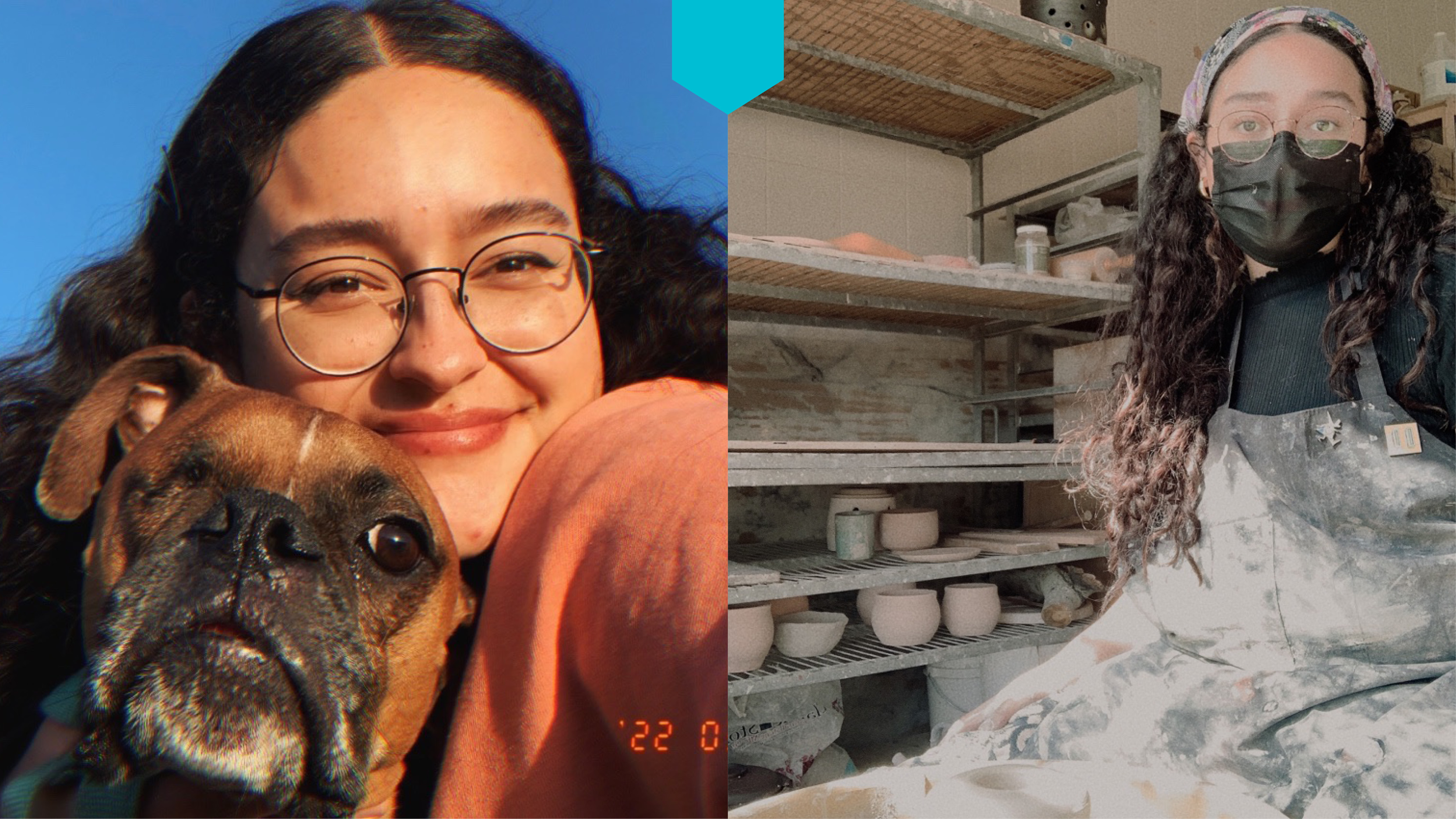 Alexandria Jensen
Alexandria Jensen
Department of Art & Art History
Pronouns: She/Her
Majored in: Art Teaching with K-12 Licensure
Hometown: Salt Lake City
Three words that describe you: Kind, Passionate, Creative
Most impactful class or professor: Beth Krensky really encouraged and inspired me throughout my time in the College of Fine Arts. The kindness and care that she radiates to all of her students is so important, and her passion for art education further reinforced my choice to be an art educator.
A CFA moment you’ll never forget: I really loved all of my studio courses throughout my time at the CFA. I was able to learn about and explore so many different mediums and develop a newfound passion for ceramics. I am really grateful to all my professors who encouraged me!
What inspires you: My students inspire me. Seeing them make discoveries and breakthroughs when exploring different artistic processes always inspires me to create and explore with my own artwork.
Summary of major accomplishments on or off campus: I have accepted a position as the ceramics teacher at a school in the community I have been working with youth in for five years.
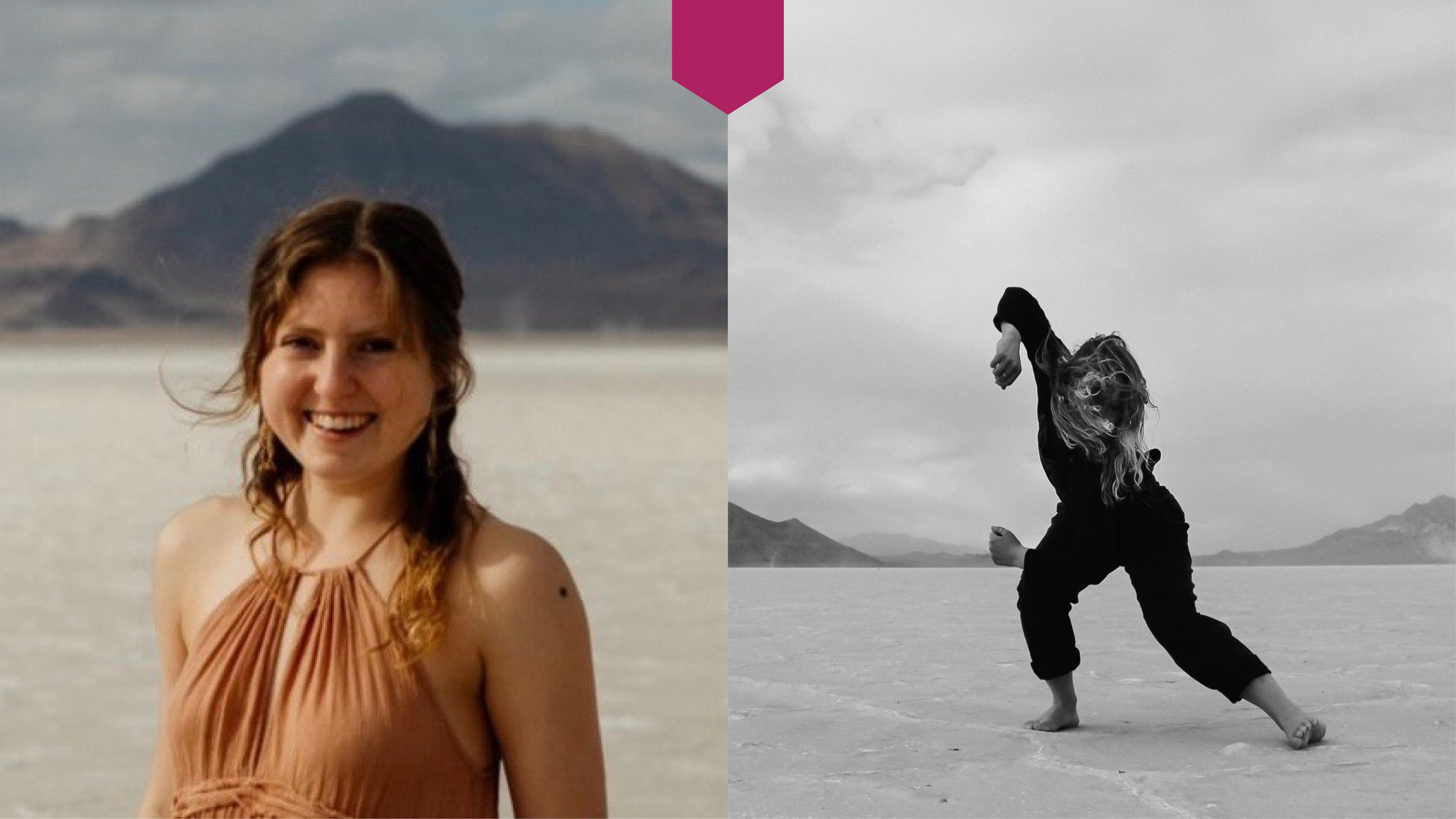
Fiona Thomas
School of Dance
Pronouns: she/her/hers
Majored in: BFA in Modern Dance, Minor in Entrepreneurship
Hometown: Seattle, WA
Three words that describe you: passionate, curious, tenderhearted
Most impactful class or professor: It feels impossible to choose the most impactful class or professor because each one has been such a tremendous part of my journey. I will say that Contemporary Views was the first class that helped me acknowledge my fears and accomplishments simultaneously. Understanding my worth and passion as an artist is the most valuable thing I have gained as a student.
A CFA moment you’ll never forget: When I sang for Satu and Daniel's piece in the Fall Show, called 'remember everything that spring can bring (2020 Ballads)'
What inspires you: Being around others that care deeply about something, and knowing that art can make change.
Summary of major accomplishments on or off campus:
- Volunteered with Healing in Motion Dance in 2018 and 2019
- Taught creative dance to youth at the Utah Refugee Center at the Meadowbrook Campus site in 2019 and 2020
- During Covid, Fiona was based in Seattle and taught a variety of classes remotely at All That Dance and at Olympic Hills, a local elementary school
- Fiona has been a part of faculty works with Eric Handman and Daniel Clifton as well as Graduate Thesis works with Alexandra Barbier and Jessica Boone"
- Created a collaborative work with Lia Wong to be premiered at the Spring Student Concert in February of 2020
- Fiona has been in numerous works by fellow peers and classmates in Senior shows, Student Concerts, and Graduate shows
- Served on student concert committee in 2020 and 2021
- Choreographed and performed a solo this spring that her and Daniel Clifton co-created the music for, titled 'To wonder is to live. And I am the wolf'
- This semester, Fiona is interning with Heartland, a collective directed by Molly Heller
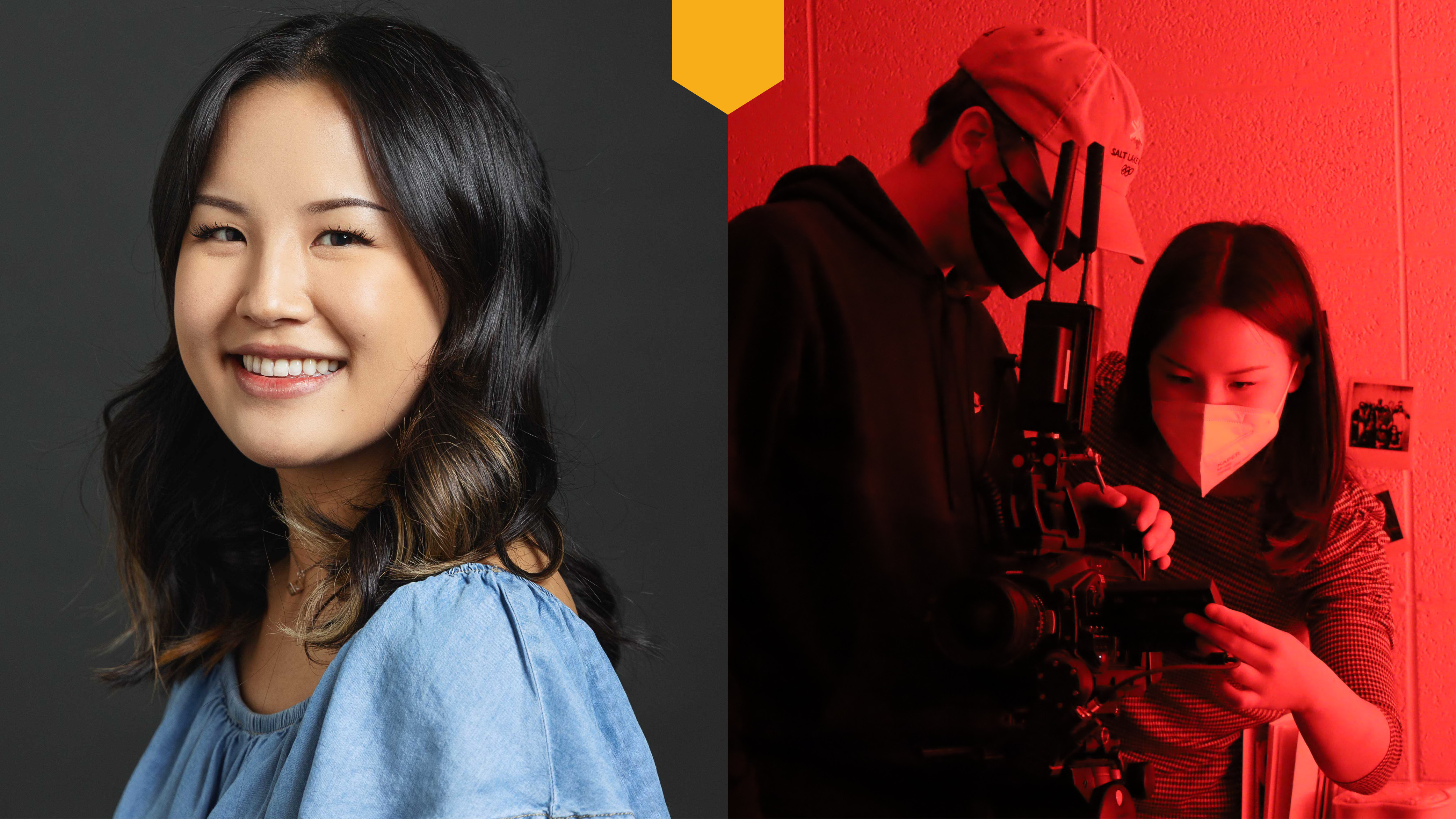
Yein Ji
Department of Film & Media Arts
Pronouns: She/Her/Hers
Majored in: Film & Media Arts BFA
Hometown: North Salt Lake
Three words that describe you: Dependable, Intuitive, Ambitious
Most impactful class or professor: Sonia & Miriam Albert-Sobrino. They are always full of energy and passion for filmmaking. They always make me laugh and they’re incredibly knowledgeable. Everyone in the film department knows how amazing these women are. They inspire me to work harder and create beautiful art.
A CFA moment you’ll never forget: The F&MAD Festival last spring. I got to watch and celebrate the films made by me and my talented friends.
What inspires you: My family. They’ve always been supportive of everything I do. They’ve starred in some of my film projects and are always excited for my next creation.
Summary of major accomplishments on or off-campus:
- Vice President of Film Production Club
- 2021 Queer Spectra Arts Festival Intern
- 2 Semesters of Undergraduate Research
- Pretty Girl film published in Undergraduate Literary Magazine
- Cheers films showcased at Utah Arts Festival
- Helped create 34 films
- Directed 8 films
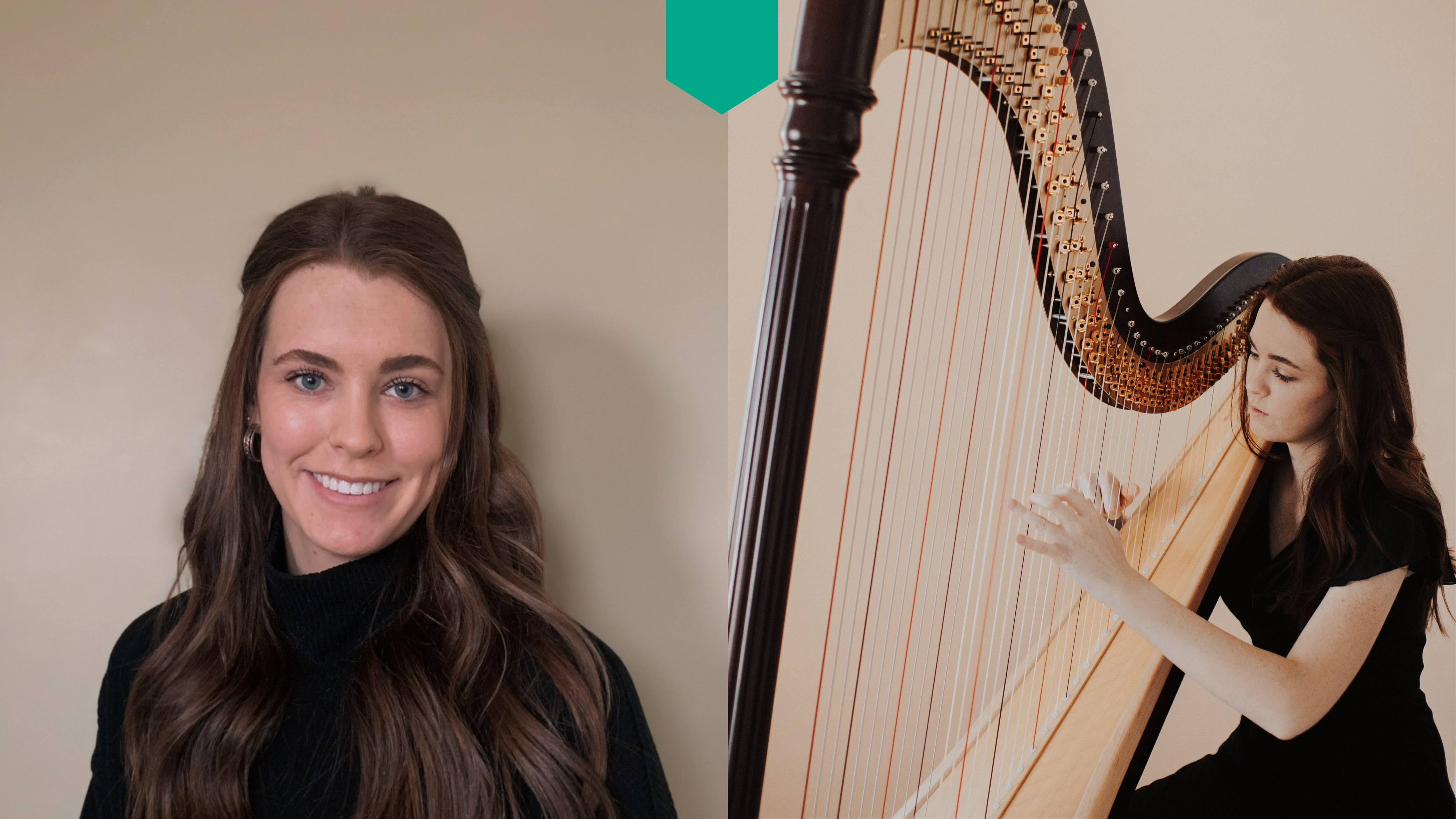
Merinda Christensen
School of Music
Pronouns: she/her/hers
Majored in: Instrumental Performance - Harp
Hometown: West Bountiful, UT
Three words that describe you: Outgoing, Ambitious, Compassionate
Most impactful class or professor: Dr. Cathy Clayton. Cathy has been my private harp instructor over the last 4 years and welcomed me with open arms when I made my transfer from the University of Arizona to Utah. She has always been so supportive as I have found my career path and I’m grateful for the time I’ve been able to spend studying under her while here at the U.
A CFA moment you’ll never forget: I had the most amazing opportunity to be an Emerging Leaders Intern for ArtsForce in the CFA that has really prepared and paved a path for me as I continue on with my career after graduation. The friendships and connections made while a part of ArtsForce is something I will always cherish after leaving the College of Fine Arts.
What inspires you: I’m inspired by people that are passionate about what they do and work hard to accomplish their goals.
Summary of major accomplishments on or off campus:
- President for the School of Music Harp Ensemble: Harps at the U of U 2019 - 2022
- ArtsForce intern for the CFA 2020 - 2021
- Awarded Internship of the Year with ArtsForce from the Career and Professional Development Center 2021
- First recipient of the Music Entrepreneurship Certificate from the University of Utah School of Music 2022
- Marketing and Communications intern for UtahPresents at Kingsbury Hall 2021 - 2022
- Event Chair and summer intern for Women’s Artistic Leadership Initiative 2020 - 2021
- Crimson Mentor for transfer students at the University of Utah 2020 - 2021
- Carmen Morton Christensen scholarship recipient 2018 - 2022
- Program Assistant for THE BLOCKS: organization under the Downtown Alliance and SLC Chamber of Commerce, offered through my internship with ArtsForce
- Director of Development for Opera Mississippi, offered through connections made while completing the Music Entrepreneurship Certificate
Danny Borba
Department of Theatre
Pronouns: he/him/el
Majored in: Bachelor of Fine Arts, Emphasis: Actor Training Program; Minor: Ethnic Studies
Hometown: Orem, Ut
Three words that describe you: Respectful, Determined, Outgoing
Most impactful class or professor : This one is a hard one! So I am mentioning a couple of things:
Andra Harbold and her wisdom regarding directing has been something that continues to bring so much joy and light into my journey as an artist and a human.
Robert Scott Smith always pushes me to be better and innovate with the art.
Nathan Brian’s belief in me as a vocalist and an artist has helped me push through tough times.
Jerry Gardner has brought me peace and inspiration through Butoh and through my interactions with him.
Sarah Shippobotham amazes me continuously with the knowledge she imparts through Shakespeare or Dialects or text work.
All of these professors and mentors (and plenty more) have pushed me to better, while also believed in me as an individual, and have encouraged me to make the theatre arts a place of inclusion and innovation. I will forever be grateful.
A CFA moment you’ll never forget: My first ArtsBash, about 4 years ago. It was the first time performing as a U of U students, and also the first time seeing how wonderfully diverse and big the College is!
What inspires you: In a specific example, Viola Davis’ journey as an artist and a human has always given comfort and inspiration. But I also want to think about my family and God. Their support and their own stories have been critical in my growth as an artist, but also as a human being. Without them, and I mean ALL of them, I would not be who I am today, or doing what I do.
Summary of major accomplishments on or off campus: Not going to lie, being a part of High School Musical: The Musical: The Series was pretty amazing, and being able to intern at Pioneer Theatre was a major goal accomplished, but one thing that stands out was being able to create a BIPOC community with my friends and establish that we belong here and aren’t going anywhere has been a very important thing for me.

